
















































By RISÉ SANDERS-WEIR Contributing Reporter
When eating out I often think, I hope this restaurant composts what I leave on my plate. Until recently the answer in Oak Park was no, but not because they didn’t want to
“When we opened our doors in April of 2020 we had wanted to do composting from the very beginning. It’s the right thing to do,” said Adrienne Guldin, co-owner of The Daly Bagel.
But it was also the hard thing to do. The cost and logistics of composting is usually more than a small business owner can handle alone.
“It’s a matter of accessibility because it’s hard if you’re just one person doing something and then also the assurance that stuf f is actually getting composted,” said Michelle Mascaro, owner of The Happy Apple Pie Shop.
Takeout 25 is trying to change that. The local nonprofit worked to have Oak Park certified as a Green Dining Hub by the Illinois Green Business Program and decided to use that platform to address the composting challenge.
“Early on, we decided that commercial composting is going to be an important part of it. None of the villages around offer commercial composting. It’s residential only,”

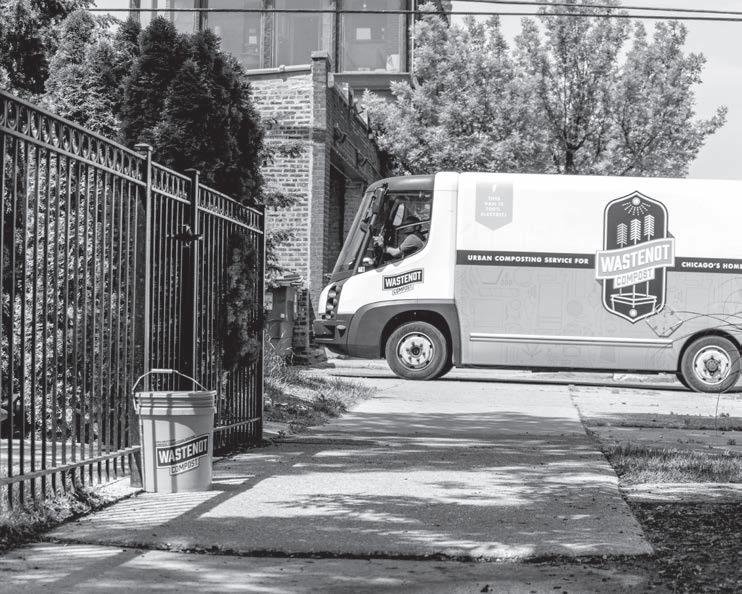
said Ravi Parakkat, founder of Takeout 25.
To encourage local restaurants to compost, Takeout 25 is offering $500 grants toward the cost.
“It’s a one-time grant for the first 25 restaurants that sign up,” he said.
WasteNot Compost is their partner organization. Founder and CEO Liam Donnelly started the company when he was 15 years old while working in a café. He be gan taking coffee grounds home to his family’s compost pile.
“My manager offered to start paying me to do it,” Donnelly said. “Getting paid to do something I was already doing and passionate about was exciting.”
Fast forward 11 years.
“There’s demand for composting. People want to do it, but the logistics that go into picking up food waste is pretty difficult. Different from standard municipal solid waste because you’re taking the densest, wettest portion of the waste stream,” he said.
Most of WasteNot’s composting is done within the city limits of Chicago, using an aerobic process. It’s like a backyard compost pile, but at industrial scale.
Through research and development, WasteNot aims to continue to expand what they can accept.
“If the product says compostable, we need

to be able to accept it because I don’t want to ever get to a point where it’s similar to the shenanigans that go into the blue bin recycling,” Donnelly said.
By encouraging participation, Takeout 25 has eased some of the burden from individual restaurants.
“The more restaurants that sign up for this, it allows WasteNot plan their routes for collection more effectively and the lower the price point is going to be,” Parakkat explained.
Current prices range from $25 to $50 per week, depending on the nature of the business. Two restaurants have signed up so far: The Happy Apple Pie Shop and The Daly Bagel.
WasteNot Compost picks up organic materials with their fleet of electric trucks. The resulting compost is returned to customers who want it
“The goal of why we compost is to reduce methane emissions on a large scale,” Donnelly said. “But there’s a secondary motivator, which is the nutrient rich soil amendment that that food waste creates.”
“As we can compost more, we’ll be able to put less in our regular trash dumpster,” Guldin said. “And so, in theory, we will be able to reduce our number of pickups for regular trash. But it’s really about reducing our envi-
ronmental impact as much as we can.” Staff training hasn’t been a problem, the two participating restaurant owners said.
“Having a WasteNot come and work on this with us was really important,” Mascaro said. “Staff for everybody is infinitely trainable. If there’s something that comes from food product. It goes in the compost!”
WasteNot Compost and Takeout 25 both work to ensure that compostable containers and packaging is available at an affordable cost to the restaurants.
“Over time we will move the needle and create benefits community wide,” Parakkat said. “It will take time, but we will get there.”
For now, the two business owners involved feel the effort is worthwhile
“Composting was always sort of there as the dream,” Guldin said. “In the p ast it was prohibitively expensive, because nobody wanted to do this sort of smallscale composting.”
“Restaurants want to compost,” Donnelly said. “Now, they know that they’re going through a shared experience with their neighboring businesses. It’s a support network. It lowers the barrier to entry.”
At The Happy Apple Pie Shop, Mascaro said, “we have a sign that says we compost. And I think that it makes people happy to know that.”
Sunday, June 30, 6 - 7:30 p.m., Scoville Park
Free, family-friendly entertainment. Enjoy music every Sunday in Scoville Park. This week features Toy Robots, a classic rock, 80s, 90s, current alt rock, and originals band. Lake Street and Oak Park Avenue
Sunday, June 30, - 2 p.m., Pleasant Home

Unlock the Secrets of the Victorian Era with The Language of Flowers. Explore the captivating art of oriography in an engaging and fun presentation decoding the hidden messages behind beautifully arranged blooms. Learn the Victorian language of owers, see how to create a tussie mussy We will also have docents on hand for tours of Pleasant Home. Ages 16+. https://tinyurl.com/2s4y695u, 217 Home Ave, Oak Park
Thursday, June 27, 10 a.m. - 12 p.m., Oak Park Public Library - Creative Studio
Have a tech question? Join our monthly Tech Help Drop-In sessions for 15 minutes of assistance with laptops, tablets, and smartphones. No registration required. Masks are required. Register at https://tinyurl. com/27nz7bkd 834 Lake St., Oak Park
Friday, June 28, 10 - 11 a.m., Oak Park Public Library - Outside Plaza
Join us for a seek-and- nd stroll through Scoville Park to learn about the colors of the Pride ag. Read “Our Rainbow,” nd hidden scar ves, and take home a prize. Best for ages 2+ with a caregiver. Register at https:// tinyurl.com/4ecuaf7w 834 Lake St., Oak Park
Wednesday, July 3, 3-5 p.m., Maze Branch Library Board games, video games, and card games. All teens ages 13-18 are welcome. Stay afterward for a Dungeons and Dragons session star ting at 4 p.m. Feel free to bring a friend. 845 Gunderson Ave., Oak Park

Sunday, June 30, 5:30 - 8 p.m., Cheney Mansion
Prepare to be whisked away to the dazzling world of Regency England for a night of elegance and enchantment at Cheney Mansion. Inspired by the opulent universe of Bridger ton, this exquisite event invites you to don your nest gowns and tailcoats for an elegant evening. A trio of strings playing your favorite music, dance lessons of the quadrille and waltz and the beautiful grounds of Cheney at twilight, all under the watchful eye of the Queen. Our bu et, paired with your choice of champagne, wine, and non alcoholic drinks are included in your registration. Ages 21+ https://tinyurl.com/5n6y2r fn, 220 Nor th Euclid Ave., Oak Park

Monday, July 1 – Wednesday, July 31, All Day, Oak Park Public Library - Main Librar y Idea Box
Join us this month to explore disability culture, community, and advocac y. Celebrate Disability Pride Month with activities and information highlighting the experiences and contributions of people with disabilities. Register at https://tinyurl.com/28hn7nrb, 834 Lake St., Oak Park
Tuesday, July 2, 1 - 2 p.m., Oak Park Public Library - Creative Studio
Learn to design a keychain using a browser-based tool and the Glowforge laser cutter. Get guided through the steps to prepare your design, see a demo, and sign up for a cutting time during Open Hours. For ages 14+, under 14 with an adult. Register at https://tinyurl. com/4sks2zz5, 834 Lake St

Wednesday, July 3, 2-3 p.m., Oak Park Public Library Middle school students, come for some summertime fun and games We’ll host “old school” games like Tag, Simon Says, Johnny Come Across, and more. Make summer Wednesdays the best day ever. 834 Lake St., Oak Park
High school o cials are searching for a campus security
By AMARIS E. RODRIGUEZ Staff Reporter
After three directors of campus security in two years, OPRF High School Supt. Greg Johnson acknowledges the school needs some stability.
“We have had some challenges recently certainly with keeping our director position staffed,” Johnson said. A look at the departures illustrates the problem:
■ Both the director and the assistant director of campus safety positions are open.
■ Traycee Love, who assumed the director position in January, left in April.
■ Eddie Stokes, the for mer assistant director, resigned from his position in May.
■ Cherylynn Jones-McLeod resigned from the director position in June 2023.
■ Cindy Guerra filled the director role for less than five months before resigning in November 2023.
Three positions are now open, including for director and the assistant.
Love, Jones-McLeod and Guerra all have said they left for “personal reasons.” Neither Stokes nor Love could be reached for comment.
However, Johnson said, Love was highly respected among the campus security staf f.
“Traccye [Love], who just left the position, was widely respected and liked,” Johnson said. “[She] was really doing quite a bit, I think, to help folks feel comfortable and welcomed and have a sense of belonging in the safety and security role.”
There are 42 full and part-time team members who are overseen by the campus safety supervisor during the afternoons and evenings, and by the assistant director of campus safety during the re gular school day. This is according to David Narain,
assistant principal of presented a campus security procedures update to the board during the June committee of a whole meeting.
The problem, Johnson explained, is that the directorship can be a challenging role.
“It is a position that is a position that has a lot of eyes on it and with that comes a lot of of pressur position.”
Johnson added that the position is a “blend of two positions,” because it quires someone who not only has a strong safety experience but also someone who can navigate and school boards.
“We have Johnson said. “This challenges … but they do good But the district needs to find someone who can help us to ha ciation for are going for,” Johnson said.

The openings come as OPRF struggled with lockdowns, fights and other security threats this year, although Narain said at an early June committee of the whole meeting that there were “there were really no major incidents.”
The first “soft lockdown” was issued in December, and the second “secure and teach” lockdown on Feb. 14 after a student claimed to have a gun and made threats via Snapchat to shoot inside the building.
A “secure and teach” lockdown is called when a “threat is outside the building or an investigation is needed in the building.”
During a “secure and teach” teachers secure students in a classroom and continue to teach as usual, ignoring passing periods until the lockdown is lifted.
Re ports also showed that 67 re ports of “inappropriate physical contact (non-sexual),” occur red, a decrease from 82 the year before. The district also re ported the same number of “actual fights” for both 2024 and
2023, with 10 fights re ported.
“As you know, we had two campus safety directors, we also had two ‘secure and teach’ but we learned, and we grew from those. Overall, we would say it was a good year,” Narain told the board.
He recommended that all protocols be reviewed with staf f and students at the beginning of each semester, coordinating and assigning staf f to assist with hallway monitoring and classroom teachers, and to communicate with PE teachers through radios to help concerns about exposure in PE spaces.
It is not clear how his recommendations matched those made by leaders in the security department.
Narain also recommended the high school adopt a partnership with “I Love U Guys,” a foundation dedicated to providing crisis response and post-crisis reunification to more than 50,000 districts, schools, agencies, and other organizations around the world.
This would allow the high school to be
“aligned” with feeder schools, said Narain, adding it would be consistent with language and training.
ALICE, Alert, Lockdown, Inform, Counter, Evacuate, training was also recommended. ALICE training would provide the district with tools to support, train, and perform school safety drills and exercises in the event of an active shooter.
“That is something that is a high recommendation from us to prepare our faculty and make them feel safer in the event of a major school incident,” he said.
He also suggested that the district focus on personnel recommendations, such as de-escalation and conflict resolution training, assigning leaders to each floor and route all classroom concerns through them, and possibly swap the shifts the director and assistant work
Johnson said the district is in the hiring process, and he hopes the director position will be filled by the end of the month.
He said he is confident the district will find the right people for the job.
By LUZANE DRAUGHON Staff Reporter
As the Oak Park Re gional Housing Center struggles with finances and funding — problems so severe that staff were not paid on time for seven weeks in 2023 — village trustees said they do not feel confident in funding the organization until cor rective action and accountability is taken.
Trustees did not vote June 18, but said they were disappointed by what they called a lack of corrective action from the OPRHC despite strong personal support for the organization’s role in the village.
“All I heard was a lack of accountability,” Village President Vicki Scaman said. “I am devastated that this is the inevitable reality. We can no longer put the blame on the village.”
OPRHC Executive Director Athena Williams has disputed alle gations she has mismanaged the organization’s money and said a lack of funding contributed to the problems.
She told Wednesday Journal that without enough funding to pay of f debt from
2023 and operate in 2024, Live in Oak Park, an esteemed program that helps foster racial inte gration in the village, will have to be shut down.
This is part of the OPRHC’s mission as a nonprofit organization “to achieve vibrant communities and promote intentional and stable residential inte gration throughout Oak Park and the re gion.”
“The inte gration work has helped to increase the overall value of the community,” Williams has said. “This work is intentional. We have to continue to do this work, to make this difference.”
But now, the Live in Oak Park program will likely be shut down.
At the June 18 village board meeting, 12 residents spoke in support of the housing center during public comment, including OPRHC current and for mer board members and employees. The commenters expressed their support for continuing to foster racial inte gration in the village through a continued partnership with the housing center.
Scaman, however, responded angrily to some comments that she said accused the vil-
lage board and village staff of unprofessional behavior while addressing issues with the housing center. Other trustees agreed, also defending the integrity of Village Manager Kevin Jackson and village staf f.
Funding for the OPRHC has come into question for several reasons. The village paused funding for the organization in August 2023 after discovering the housing center had an “inactive status” with the United States Department of Housing and Urban Development, a center funder, for its West Cook Homeownership program. HUD also put the organization on probation last year, which was extended to October 2024.
A financial monitoring shortly after the village paused funding revealed housing center staff had not been paid for three pay periods in 2023. The wages were later received
And last fall, Kolnicki, Peterson & Wirth, a consultant hired by the village, could not complete its performance review of OPRHC because of what it said was the lack of financial documentation from the center.
Finally, village officials said the housing center ended fiscal year 2023 with a deficit of about $356,617.
nancial
Wi lliams, however, has c ountered, saying she is operating at a loss, not deficit According to her, the problem is more of a c ash fl ow i ssue. Wi thout village f unding, Wi lliams a dded, staf f salaries needed to be paid from other f und s, and she needed to take out lines of credit to continue operating.
Now, Williams said she’s open to oversight from the village, but that the lack of funding has harmed the agency, including staf f and clients. Trustees, however, pointed out the longstanding struggling relationship between the village and the housing center.
“We don’t have a healthy partnership,” Trustee Lucia Robinson said.
Scaman said she believes the housing center may be threatened due to “poor management.” Trustee Susan Buchanan also listed several instances of late financial re ports from the housing center, calling it “mind blowing” that Williams said she didn’t recall all of them.
Village trustees and housing center officials both expressed desires to find a path forward together.
The Live in Oak Park program will be shut down due to a lack of funding, the center’s leader counters
By LUZANE DRAUGHON Staff Reporter
Despite overwhelming support from advocates of the Oak Park Re gional Housing Center at a village board meeting last week, trustees said they are not inclined to continue to fund the organization because of its troubling financial issues.
Trustee Susan Buchanan called the center’s situation a “financial quagmire” and “unacce ptable” at the meeting. But what does this mean?
To Athena Williams, OPRHC’s executive director, it means that unless the village continues its funding, the Live in Oak Park program, which helps foster racial integration in the village, will be shut down 30 days from that June 18 meeting. It means
three full-time staf f members will be laid of f, along with one part-time employee, and their hours have already been cut.
“After a year of no funding, I cannot continue to fund the program,” Williams said. “I would like to not see it go.”
To Trustee Lucia Robinson, she hopes it means Williams and housing center staf f will take the time to self-assess their financial problems and to take corrective action.
She quoted a statement from a U.S. Department of Housing and Urban Development re port that said the housing center does “not appear to be financially capable to perform and administer the grant in compliance with all [regulations].”
“There are serious, serious financial challenges faced by this organization,” Robinson said.
The village began debating whether to continue support for the housing center for several reasons, including because it received an “inactive” status with HUD in 2023 after it delayed staf f salaries, and because it received an inconclusive financial review from a village auditor. Williams has disputed alle gations that she has mismanaged the organization’s money and said a lack of funding contributed to the problems.
Both sides appear to be standing their ground with tough decisions ahead.
At the meeting, every public comment ahead of the trustees’ discussion re garding the housing center was vehemently
supporting the organization. Commenters said its mission should continue in the village, with one person calling it “inconceivable” that the board would “walk away.”
The 52-year-old respected center’s mission is “to achieve vibrant communities and promote intentional and stable residential inte gration throughout Oak Park and the re gion.”
Daniel Lauber, who has served on the OPRHC board in the past, said he’s witnessed how other villages have lost fostered inte gration after closing their respective housing centers. He said he doesn’t want to see that happen in Oak Park
“Oak Park didn’t get here by accident,” he said. “It took considered effor ts that I’m afraid a great many members of the village staf f seem to be unaware of.”
Michael Stewart, an OPRHC employee, also said larger management companies could take over small housing providers and increase rent prices.
“It’s this partnership that has profoundly advanced our culture, our commitment to the values of equity, inclusion and justice,” said Rob Breymaier, a for mer executive director of the OPRHC. “Separate can never be equal.”
Lauber and others accused Village Manager Kevin Jackson and village staf f of unfair conduct, adding that the village does not appear interested in maintaining the housing center.
“Is it at all possible that the village manager’s lack of specificity in his expectations of the housing center has anything to do with your [trustees’] lack of expectations of him?” resident Ralph Lee asked.
But Village President Vicki Scaman, along with other trustees, refuted the claim that Jackson or any staff acted unfairly.
“Any accusations that our staf f have been anything but professional or fair is completely uncalled for,” she said.
Williams did not present what the board considered a comprehensive corrective action plan at the June 18 meeting, and board members did not appear pleased.
“I don’t know how we move forward from here, how we would simply greenlight funding from here when what I don’t see is an actual plan,” Trustee Brian Straw said.
Robinson pointed out a litany of concerns, including a deteriorating relationship between the village and the housing center, that Wiliams delayed staff pay and that no accountability measures were taken. No plan to prevent the financial woes happening again was presented, she added.
Scaman said she expected a corrective action plan to be presented June 18. She said the community should hold Williams accountable for “what could potentially be the loss of a 50 plus year relationship” between the OPRHC and the village. She also said housing center staff may be “threatened because of poor management. ”
“You are disappointing your staf f,” Scaman said. “You are disappointing this community.”
Williams did not directly respond to Scaman’s comments at the meeting. However, she told Wednesday Journal that “everybody has a right to express themselves.”
Many of the board members have allocated time and ef fort to help the housing
center, Trustee Chibuike Enyia said, but it hasn’t been enough.
Buchanan also pointed out that if the village b oard we re to f und the housing c enter with C ommunity Development Block Grant f unds wh i le it is on “probationary” status with HUD, and if the organization is declared i nactive in Octobe r, the village would be liable to re pay those dollar s.
Williams countered by saying the organization does have an “active” status, and is not on probation.
Wi lliams told We d nesd ay Journal wh i le procedures she and staf f lead at the housing c enter have proven to be sufficient, she may have to review or make a djustments. S he also said that she already implemented a finance c ommittee and might a dd more oversight to meet trustees’ requests .
She said she believes she did her due diligenc e. For example, she pointed out, when it became apparent pay would be an issue due to cash flow problems, she spoke to a human resources consultant and a payroll consultant.
Williams was presented with options, including to lay staf f of f or to delay pay and make staf f aware that it would happen. She said she then spoke to the housing center’s board, who told her if staf f was OK waiting for pay, she could do that. Williams said her staf f told her they were
But when funding from the village ceased in 2023, she said she had to pay staf f salaries from other funds. The agency also took out lines of credit to perfor m basic operations, funds that have to be paid back .
“[Village] funding has been paused for almost a year now, and I’ve continued to r un the progr am without fail,” she said.
But village officials have said the OPRHC ended the fiscal year 2023 with a deficit of about $356,617. Williams argued that’s an operating loss, not all deficit.
Because the Live in Oak Park prog ram will now have to close, Williams said she’ considering fundraising to at least pay of the associated debt from 2023. But sinc the COVID-19 pandemic, she said fund raising ef for ts have been dif ficult.
But for now, the progr am will have to be shut down if there’s still a lack of fundin at the end of the 30-day period Williams budg eted for. Some say the lack of wo to foster racial inte gration could be detrimental to the community
• Kitchen and bathrooms
• Paint, drywall, patching
• Tile, vinyl or laminate flooring
• Outdoor patios, brick, stone, and so much more... Serving the Tri-Village area






By AMARIS E. RODRIGUEZ Staff Reporter
Brooks Middle School science teacher
Lary Grimaldi was put on leave in October after a student alle ged that Grimaldi grabbed his shoulder and swore at him in an attempt to send the student to the principal after “horsing around.”
Fo r months, there was no info rm atio n from either the district nor G rimald, bu t the situation has pl ayed out in public b oard meeting s. C ommunity member s supported him. T he student’s attorney d escribed the incident. G rimaldi defended himself
However, neither the district nor Grimaldi would speak to Wednesday Journal about alle gations about him that led to his leave
“In order to respect the privacy rights of our employees, the district’s practice is not to publicly comment on personnel matters,” said Amanda Sie gfried, senior director of communications and eng agement for D97.
T he student’s attorney was not able to be reached for comment.
Patience Clark-Keys, the le g al re presentative for the child involved in the incident, read aloud a letter at the June 11 board meeting. She said the incident happened after the student and another friend were “horsing around.”
According to the student, this prompted another student to believe the two were fighting and the third student came up to him and slapped him in the face
T he student pushed back and that is when Grimaldi, he said, came over and told him to go to the principal’s office. According to the student, the other two boys were sent to their class.
T he student said he be g an walking to the principal’s office, with Grimaldi following behind, when he became frustrated that he was the only student in trouble
T he student said he turned around and be g an walking over to his bike when Grimaldi grabbed the student by their backpack and said, “where the f*** are you going?”
T he student, Clark-Keys said, responded by saying that they were going home and told Grimaldi to “get your **** hands of f of me.” The student said the situation was g etting heated and Grimaldi had no identification on him identifying him as a teacher.
“I wanted to g et away from him because he seemed like he was in a rage,” the student re ported
Grimaldi, Clark-Keys said, pulled the student of f his bike by grabbing his shoulder and said, “I told you to g et the f*** of f your bike.”
“At this point I was super scared because at this point this man, who I didn’t know, seemed like they wanted to fight me,” the student re ported
T he student then detailed how the incident continued to impact them because students, volleyball players, and teachers continued to “constantly harass” him after the incident.
“This situation has really impacted
The Village of Forest Park has immediate opening for a responsible fulltime PACE Bus Driver to transport senior citizens, disabled residents and school children. Must have a valid Illinois Driver’s License, and a good driving record. In addition, must be physically fit and submit to criminal background check, annual physical exam and drug and alcohol testing.
M-F Days Starting salary $36,687 with excellent benefits. The position is a non-exempt, AFSCME union position. Apply in person at Howard Mohr Community Center, 7640 Jackson Blvd., Forest Park. 708-771-7737.
me,” said the student. “Kids who I don’ t know come up to me asking me why I got Mr. Grimaldi fired.”
Re presentatives from the district confir med Grimaldi is still employed.
Grimaldi, who also spoke during public comment during the June meeting, said he wanted to “quell the untruths that have been able spread about what occu rred.”
“One-hundred-thi rty-eight instructional days missed,” Grimaldi said. “Over 41,000 instructional minutes missed learning opportunities, teachable moments, and connections with my students and families.”
Grimaldi said the incident that occurred was something he had never experienced in his teaching career
“Without ever hearing from me about what happened and what I dealt with, the district chose to send me home on paid administrat ive leave that afternoon. What has transpired over the next eight months has been short of a nightmar e for me and my f amily.”
Grimaldi blamed the incident on the shor tcomings and failures of “policy, protocols and procedures,” of the district.
He said that when he tried to g et backup, he lacked ways to communicate with other staf f and that his calls to the district went unanswered.
“Throughout this process I wanted more than to be back in my classroom with my students and on the court with my players,” he said. “I made that known to everyone that would listen. I was denied that oppor tunity at every request.”
At the same board meeting, howeve r, here more than15 people spoke on behalf of Grimaldi, who also serves as the volleyball coach.
Stephanie Suerth, a French language teacher at Brooks Middle and co-president of the Oak Park Teachers Association, spoke on her colleague’s behalf
“Lary can be blunt. He speaks his mind frequently and without a filter,” Suerth said. “But Lary is also a fierce advocate for his collea gues and his students.”
Suer th highlighted his le gacy at D97.
“When Lary is at school, he brings joy to those around him,” Suerth said. “It was a disservice done by the district and by extension the community. He is just one example of the broken systems that we are experiencing.”
“I am especially saddened for our students and f amily who missed out on the Grimaldi experience … He is a le g end around here,” said Hannah Boudreau, OPTA member. “He is a mentor, a coach, a friend, an advisor, a trusted adult who always protects our students and lifts them up. He is a true champion of this profession, and we should be so proud he made D97 his home for his entire career.”
T he student, who has since graduated from Brooks, said he believes it’s important for Grimaldi to have “restorative conversations’’ with students and teachers, as well as admitting to the mistake.
T he student, a rising freshman at OPRF, added that they hope to leave this incident behind at Brooks and to move forward.
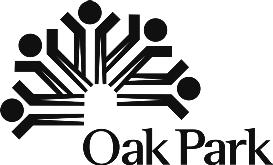

Challenge and build your strength, balance, posture, and empower yourself to move stronger everyday. Each class will incorporate aspects of strength, agility, mobility, and non-contact boxing. Seated and standing exercise modifications are made in-class so all ability levels are welcome.
Classes are led by Movement Revolution’s Neuro Exercise Specialist who are experts in developing exercise programs for neurological conditions



By AMARIS E. RODRIGUEZ Staff Reporter
Oak Park and River Forest High School is looking for ways to tackle vaping on campus with the help of vaping detectors.
During the June 6 committee of the whole board meeting, David Narain, assistant principal of operations, presented security update, which included information on vaping at the high school.
According to Narain, the district used vape sensors placed in four high-traffic restrooms, two boys’ restrooms and two in girls’ restrooms.
The data showed that there was an average of 102.3 hits per week, with about 58% of hits coming from the boys’ restrooms, and 42% from the girls’ restrooms. That’s 21.2 hits per day, with 12.4 hits coming from boys’ bathrooms and 8.9 hits from girls’ bathrooms
E xactly wh at students are smoking is n’ t clear.
According to Narain, the detectors do not break down what is detected, solely that smoke or fumes were detected.
After smoke or fumes are detected, an alert would go off to notify security staff and a camera, located outside the bathrooms, would be triggered to start recording.
“An audible alarm will sound if someone tries to tamper with the device,” Narain said.
Despite the decline of e-cigarette use among high school students – from 14.1% in 2022 to 10.0% in 2023 – vaping is still a concern.
According to the CDC’s “Tobacco Product

Students- National Youth Tobacco Survey 2023,” 22.2% of U.S. middle school and high school students reported using “any tobacco product,” with e-cigarettes remaining the most commonly used tobacco product among adolescents
“Among middle school and high school students who currently use e-cigarettes, 25.2% used e-cigarettes daily, and 89.4% used flavored e-cigarettes,” the report’s authors said.
E-cigarettes have been the most commonly used tobacco product among adolescents since 2014.
“Vaping is an epidemic across the entire country,” Narain said. “I haven’t spoken with anybody in any district that has solved this issue.”
Addressing vaping and smoking in the bathrooms is the only recommendation from the campus safety procedures update that came with an established cost.
To purchase and install vape detectors in every student restroom would cost the district approximately $140,372 and has been included in the 2025 school year budget. However, the item was brought before the board as a discussion item and Narain said it would not be brought back to the board for a vote at this time
“We have committed to further researching the use of the product in other school districts,” Narain told Wednesday Journal.
Board president Tom Cofsky said he agreed with continuing to gather information on how successful vape detection programs have been in other districts.
“There is really no guarantee that the system really addresses the problem,” Narain said.
The product would only be detecting that vaping is happening, said Narain, adding
that there is a chance that behavior is just redirected to a different location on campus
But many school districts across the country have already begun to install or have announced their plans to install vape detectors.
According to Education Week, in 2023 the Montgomery County school district in Maryland announced they would pilot detectors in five of the 26 high schools in the district. According to the article, the district, one of the largest in the country, planned to use an expected financial settlement with Juul, an e-cigarette manufacturer, to finance the purchase of the detectors, a move adopted by other districts across the country.
Juul reached settlements with states and school districts across the country, including an approximate $67.6 million settlement with the state of Illinois, who sued Juul in 2019 for marketing harmful nicotine products to minors.
Narain said that vaping, “at its root,” is a social emotional concern. According to Narain, there are already initiatives at the high school to tackle vaping from a “social emotional learning” lens.
Students caught by the detector would have to be subjected to a behavior education plan, which would include serving an inschool reflection, said Lynda J. Parker, assistant superintendent and principal at OPRF
“There is a curriculum through 3rd Millennium Classroom [an organization that provides evidence-based online prevention and intervention courses for various categories including nicotine, alcohol, and cannabis and other drugs] that students do, so there is some education as well as the use of a way back in,” Parker said. “There is the social emotions piece that we do give to the students if they are detected in this.”
But the school needs to do something, said
parents in the community
“Many students vape at OPRF and it is not a priority for the staf f,” said Gail Gearhart, a community member. “The students always smoke in the bathrooms. No one monitors this. For the teachers, it’s not their job and they turn a blind eye to the problems. Hall monitors are very spread out and they only really have a reaction when there is a fight. T he kids at OPRF get away with vaping and there are no consequences.”
But the effects can be really damaging , said a for mer OPRF parent who pulled their child from the high school after they were alle gedly introduced to vaping and marijuana in the bathrooms during passing periods. T he parent asked for their name to be withheld to protect thei r child’s identity.
“I think she had a ‘hit’ before almost every class,” the parent said. “This greatly impacted her mental health and I pulled her from the school. It is inconceivable to me that we pay so much in taxes and can’t hold kids accountable to using illicit substances in school.”
Aaron McManus, community member, said having conversations with students about certain dangers of vaping, including counterfeit vapes, is a great way to emphasize the health risks for students.
“There’s a ton of vapes that are made with absolutely identical packaging to the real thing, but they use cheap chemicals that have put people in the hospitals or even killed them,” McManus said. “A lot of folks buy counterfeit vapes from corner stores and gas stations, thinking that they’re buying a legitimate product. A lot of store owners think they’re selling the real stuff when they’re not.”


By LUZANE DRAUGHON Staff Reporter
Oak Park officials are looking to expand inter net access in multi-unit buildings, in an attempt to bring equity of the “critical resource,” to marginalized and lowincome households.
Residents who can afford to live in singlefamily homes typically have more options when it comes to internet connection or may be able to more easily afford high-speed connection. But multi-unit residents shouldn’t be left out of accessing a resource needed for day-to-day necessities such as school, work or even healthcare appointments, officials said. Ensuring equitable internet access could be considered part of the village’s desire to be committed to “equity, diversity and inclusion because these values make us a desirable and strong community for all people.”
In 2021, for example, the village board adopted a goal of exploring af fordability of internet services. One way to help reach that goal is to ensure access in multi-unit residential buildings, and preferably high-speed access.
High-speed internet service is considered 100 megabytes or higher. In an April 2023 study of 188 multi-unit residential buildings, those with four or more units, the village’s information technology staff found that highspeed internet with AT&T, a common local provider, was only available in 66 units. They discovered that low speed through AT&T was available in 90 units and that 32 units had no access at all. Now, there are three more units with high-speed access, for a total of 69.
Village officials are trying to expand that access, but don’t yet know what solutions might look like.
The village’s civic information systems commission members agreed at their April meeting that community education on internet service providers is the next step to increase internet connectivity in Oak Park So, representatives presented their findings to the village board June 18.
“We feel by educating the residents, we are empowering them to be able to find a solution,” said Alvin Nepomuceno, the village’s information technology director.
Some locations in Oak Park offer free internet access, with no income restrictions, such

as the Oak Park Public Library. Staff at the library, however, have said the demand for that first-come, first-served internet access is larger than the available funding. They’ve also said continuous usage has caused the library to lower data speeds to maintain costs. But those lower speeds affect the user, too.
District 97 offers hotspots to students eligible for free lunch programs, and District 200 offers access through Comcast affordability initiatives, according to a February 2023 assessment of community broadband access
“Because of the unconventional device usage and long waiting list at the library, and the high device demand at D97, it appears that there may be an overall internet access equity problem in Oak Park,” officials said in the memo
“While high-speed internet is important for everyone, it is particularly important for families with school-aged children,” Trustee Brian Straw said June 18.
In 2020, Oak Park tried to improve the village’s information technology network. New infrastructure was used to help support internet access at governing bodies and District 97.
However, the CISC wrote in the 2023 memo
that the cost to expand Oak Park inter net access programs that already exist would be less expensive than the community creating its own new infrastructure.
At the June 18 village board meeting, David Baker, the CISC chairperson, pointed out that in multi-unit dwellings, residents must go through a landlord for internet access, often only getting access through one provider. Residents of single-family homes, conversely, have more options. Baker said the village should prioritize getting internet service from at least two providers into every structure in the village.
The village could also try to incentivize property owners to make multiple providers available, Baker said. But those owners may also see the benefits of having options on their own, including an increasing desire to live in those buildings
The study also found that high-speed Xfinity internet access is available in the community and could be a good option for expanding access in multi-unit dwellings. According to village officials, some CISC members think wireless 5G internet access could benefit the community, too



By LUZANE DRAUGHON Staff Reporter
Oak Park resident Robert Parks presented a petition with trustees at the June 11 village board meeting — signed by 1,875 residents — asking to delay leaf-bagging until 2025.
“The entire village should not be punished for one person’s bad mistake,” Parks said, refer ring to a car that caught on fire last fall after it was parked on top of leaves. “The final outcome should be determined by all stakeholder citizens.”
But he and the petition signers did not have their wish granted on June 18.
T he village b oard voted 4-3 to c ontinu e the leaf-bagging requirement for c ollection this fall.
Parks and other residents also asked for a referendum to vote on leaf-bagging before its implementation. The board effectively denied that request.
The original decision was made April 30 after trustees voted 5-2 in favor of leafbagging. This ends the longtime practice of raking leaves into piles on the streets. Some officials said bagging is intended to increase safety.
The leaf pile method can lead to fires –which village officials have said happen almost annually – lack of visibility, clo gged drains that contribute to flooding, and parking and biking issues. Leaf piles can also obscure children who are playing from oncoming cars.
Critics, who include residents and some members of commissions, including the aging in communities commission and disability access commission, claim the cost and physical demands are unjustified.
Lakeshore Recycling Services has stated it is unable to guarantee leaf collection in 2024 with the street-pile method, according to village officals. After the decision to switch was made in April, LRS adjusted its village operations.
Th at included c ancelling specia l equipment needed to pick up leaves in the street and r eallocating r esources to
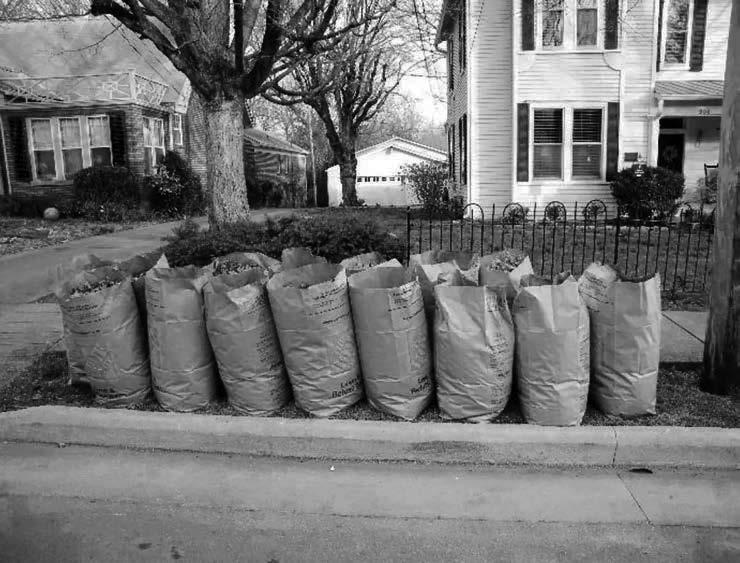
purchase a new c ollection truck. LR S also already made staffing c hanges to a ccommodate the leaf-bagging pr ogr am. Returning to the leaf-pile method may not have b een p ossible for them, village of ficals said in a re po rt
If the b oard had decided to sw itch back, the village ’s public wo rks depa rtment would have had to create a prog ra m with necessary staf f and resources fo r leaf c ollection. Vi llage staf f would then pursue other service providers, but sai d they are “not c onfident” they c ould do so in time for the season.
Switching back would have been costly. The village would have potentially needed to pay for a new service provider while still likely being contractually obligated to pay LRS for the bagging program. The total cost for that was not known, officials said. Given the additional costs associated and other factors, a majority of trustees were not supportive of delaying the program.
Village President Vicki Scaman, who originally opposed leaf-bagging, reiterated her wish that there had been more education and community buy-in for bagging leaves before the final vote.
Trustee Ravi Parakkat also opposed the original decision to bag leaves. He said he’d
like to put the issue on a referendum for the community to vote.
Trustee Chibuike Enyia moved to delay the switch at the June 18 meeting, seconded by Parakkat. They, along with Scaman, voted to postpone leaf-bagging to 2025, but were voted down.
Enyia said he doesn’t want to create an undue burden on residents who aren’t used to the extra work of bagging, especially individuals with disabilities and elderly residents
“You don’t want to start a program knowing that you’re setting someone up to not be successful,” he said. “We want to start these programs getting of f on the right foot.”
S ome residents said they are c oncerned about a larger inventory of trees on their properties, saying they’ll have to spend four figures on bags annually, Trustee Cory Wesley said.
But Rob Sproule, the village’s public works director, said that’s a “pretty unlikely situation.” Because bags cost about 50 cents, residents would need to use 2,000 bags to spend four figures. He estimated the change will cost about $7 per household.
Residents who do n’ t want to buy bags c an use any rigid c ontainer, such as a spare ga rbage c an. As long as it ’s filled only with leaves and p laced at the curb for pickup, it will wo rk .
Trustee Susan Buchanan also said she hopes residents will leave the leaves, a
sustainability initiative the village is encouraging as an alternative to bagging, to improve the village’s ecosystem.
If r esidents ra ke their leaves i nto the street, Sproule said village staf f will educate them about the new pr ogr am and give out materials to help ensure c omplianc e. A code enforcement officer would then li ke ly f ollow up. Enforcement measures c ould be taken if r esidents do not c omply over time, he said, b ut the village ’s i ntention is to ga in c omplianc e, not collect fines.
But some residents might not comply easily.
“I have had some i nteractions with f olks who suggest that they i ntended to eng age in some civil disobedienc e around leaf c ollection,” Trustee B ria n Straw said.
Resident concerns
Pa rk s, during his public c omment at the June 11 meeting, said about half of the r esidents who signed his p etition against leaf-bagging we re hearing about the change for the first time
“Most were dismayed by the speed of the decision and lack of adequate infor mation and oppor tunity for input,” he said. A nother resident echoed that concer n. He also said after years of muscle memo ry r aking leaves i nto street, some r esid ents might forg et or simply be unawar e of the c hang e, leading to a mix of bagge d and street-ra ke d leave s.
Parks said purchasing bags or h irin g p eople to bag leaves is c ostl y, as is the equipment to assist mulching, if the r esident wants to do so. And leaving the leaves in p lace is “unworkable” if there’s too man y, Parks said. It raises c oncerns about mold and fungus gr ow ing, he said.
At the June 18 meeting, Dan Yo pchick , the village ’s chie f c ommunications officer, presented a p lan to disseminate the info rm ation and to eng age the public about the i ssue, a dding that staf f is c onfident there’s enough time to spread awareness. T he village p lans seve ra l measures, including an FAQ page tha t is now av ailable on the village’s we bsit e.
In April, Erica Helms, the village ’s environmental services manage r, proposed a dding leaf c ollection to the s idewalk shoveling pr ogr am, creating a c oupon pr ogr am to reduce the c ost of bags and handing out c omplimentary bags. T hose p lans are in the wo rk s.



garden decor, toys, bikes, tools, household items and more!
The Forest Park Police Department is seeking qualified individuals for the position of Crossing Guard. This position requires flexible hours during days when schools are in session. A background investigation and drug screening will be conducted prior to consideration for the position. Applications available at Village Hall, 517 Desplaines Avenue or on-line at www.forestpark.net and should be returned to Vanessa Belmonte, HR Director, at Village Hall. For additional information, contact Dora Murphy at 708-615-6223 or write dmurphy@forestpark.net. Applications accepted until position is filled. EOE.
Hourly Rate of Pay $18.30

Regular hours 7:30 am to 8:30 am, 2:30 pm to 3:30 pm; Occasional half days 7:30 am to 8:30 am and 11:00 am to 12:30 PM
We’re on a mission to secure reparations and improve our community’s quality of life. If you support exempting descendants of slaves from property taxes in Cook County, we need your help. Every signature counts! Each one brings us closer to placing this initiative on the November ballot.


For your convenience, we can email the petition for you to print, sign in black ink, and drop off at Augusta Park, 950 N. Kilbourne on June 30, 2024, from 1�30�4pm.





A 30-year-old Elgin man was ar rested June 23 for attempted first-de gree murder that occurred March 4 on the 200 block of North Oak Park Avenue. T he man knew and targeted the victim, officials said, but the reason why is unclear.
T he victim was standing outside a building when he was approached from behind by the man, who stabbed him three times T he victim had wounds to his neck, abdomen and arm. T he man was at-lar ge unti l the ar rest over the weekend
T he Elgin Police Department took the man into custody for a separate investigation of criminal damage and ag gravated assault. He was turned over to the Oak Park Police Department. T he Cook County State’s Attorney Felony Review gave approval for one count of attempted first de gree murder June 24, officials said.
■ While two boys, both Oak Park residents, were playing in Longfellow Park June 14, they were approached by six or seven male teenagers who asked to join. When the boys ag reed, the teens began shooting airsoft-style pistols at them. The teens then fled on foot. No injuries were re ported.
■ An Oak Park resident was in his garage June 18 on the 800 block of North Humphrey Avenue when a man exited a small black SUV with tinted windows and took out a gun. He pointed the gun at the resident, who attempted to grab the gun, but was unsuccessful. The man fired two shots at the victim and hit him in the leg. The man fled in the alley.
alley June 19 on the 300 block of South Harvey Avenue and discharged 28 rounds from a firearm into the air. The person then fled.
■ Someone broke into a storage locked at the 400 block of North Austin Boulevard between April 15 and June 17. The individual stole a blue sectional couch, a glass coffee table and two glass side tables. The estimated loss is $1,900.
■ Someone shattered a window and broke into an Oak Park resident’s black 2019 Mercedes-Benz GLC 300 while it was parked on the 1000 block of Randolph Street on June 20. T he person stole a duffle bag containing numerous items, including clothes, a gun holster and a sleeping bag. T he estimated loss and damage are $3,000.
■ A 37-year-old Chicago man was arrested June 14 in Maywood for aggravated battery to an Oak Park police officer. He was held for bond hearings.
■ A boy from Chicago was arrested June 14 in Chicago for an aggravated car hijacking that occurred on the 0-100 block of Lake Street. He was taken to a juvenile detention center in Chicago.
■ A 28-year-old Hillside man was arrested June 17 for domestic battery against an Oak Park resident and an active warrant. He was held for bond hearing court.


■ While an Oak Park resident was inside a detached garage June 15 on the 1100 block of Schneider Avenue, she heard four to five gunshots. She then saw four holes in the garage wall that also went through a metal ladder and one of the car windows of a gray Ford Escape. The estimated damage is $1,000.
■ Someone in a dark sedan drove into an
These items were obtained from Oak Park Police Department re ports dated June 14 - 24 and re present a portion of the incidents to which police responded. Anyone named in these re ports has only been charged with a crime and cases have not yet been adjudicated. We re port the race of a suspect only when a serious crime has been committed, the suspect is still at large, and police have provided us with a detailed physical description of the suspect as they seek the public’s help in making an arrest.
Compiled by Luzane Draughon


Terrence Hunter per forms at the Village Pride Party on June 22.
Oak Park’s pride festival on Hall’s south lawn was all rainbows in a family-friendly event featuring ice cream, face painting, a DJ, games, a bounce house and a magician. Oak Park has a long history of supporting the LGBTQ+ community: It was one of the first municipalities to make diversity a matter of public policy with a diversity statement.



















Students spoke about Black liberation or the importance of celebrating Juneteenth in the inaugural event
By DEBORAH BAYLISS Contributing Reporter
Adande Becton, an 11-year homeschooled gi rl from Maywood, was among the winners of A SE Production’s first, Jubilee SPEAKS! Oratorical E ssay C ompetition held at T he 19th C entury C haritable A ssociation this month in observance of the Juneteenth national holiday.
Wearing red as a symbol of the b lood and r esilience of their ancestors who did not make it to freedom – and p lenty of Black pride – elementary through high school students d elive red speeches and essays on either Black l iberation or the impor tance of celebrating Juneteenth.
Wi th a little help from her dad, Eric Becton, the young influencer, who also has a makeup tutorial Youtube c hannel c alled Sparkle Girls HQ, said the g oal of her essay was to make c lear why it ’s impor tant for African American descend ants of enslave d ancestors to c elebrate wh at ’s now a federally mandated holiday.
“In my speech I said, ‘We should c ele brate Juneteenth because it c elebrates the ending of some of the harshest oppression of A frican p eople and we should make the c elebration about learning wh at was inflicted on humanity.”
Re corded as June 19, 1865, two and half years after A braham Lincoln signed the E mancipation Proclamation, Maj. Gen. Gordon Granger arrive d in Galveston Bay, Texas, with 2,000 Union troops to tell the more than 250,000 enslave d Blac k p eople that they we re free.
At the c ompetition, emp owered with the conviction to share the truth of thei r histor y, the pa rt icipants we re judged on pois e, effect, clarity and content.
The winners were: Adeyemi Griffin, an
Oak Parker who attends Gwendolyn Brooks Middle School; Ryann Dawson from Broadview, a rising junior at Fenwick High School; Maya Dawson, a Lindop Elementary School student also from Broadview; and Peyton Worsham from River Forest, a Roosevelt Middle School student.
Broadview mayor, Katrina Thompson was present to hear the girls’ presentation.
Wi nners rece ived $150 c ash priz e, a $25 g ift card and a “swag bag” filled with things such as a Juneteenth j ournal, a bag filled with health maintenance products, a Black Gi rl Magic makeup bag, T- shi rt created by local Black owned Shab by Fl y Design s, b ooks about Juneteenth and Black inventors from A friware Books, Gifts and Cultural Events
Oak Pa rkers Aliyah Bryant, Gwendolyn Brooks M iddle School, and Journey Wi lli s, Oak Pa rk Rive r Fo r est High School we re the two emcees who pa rticipated in the event. T hey rece ived a sw ag bag and a $50 Vi sa g ift card. A high school student vendor and the fl ag b earer also rece ived a $50 Vi sa gift card
Oak Pa rk C ommunity Relations C ommissioner Juanta G riffin, f ounder of A se’ Productions, a c ommunity organization that aims to uplift Black c ultur e in Oak Pa rk and neighboring c ommunities, org anized and hosted the event to provide youth a more prominent vo ic e in Juneteenth observanc e.
Her 13-year old d aughter, Adeyemi was one of the winner s.
“My favo rite pa rt in her speech about the importance of c elebrating Juneteenth is her line about her favo rit e thing about Juneteenth [which] is line d ancing with her gr andma. S he also sai d that l iberation and freedom is not something that anyone else c an give us, it ’s something that we give ourselves.”
G riffin praised all the speeches, noting how well-written and well-delive red they all we re. Ryan Dawson, for i nstanc e, spoke in her Black l iberation-themed speech about how A frican A mericans are still wo rk ing toward their freedom and going through the same struggles
g
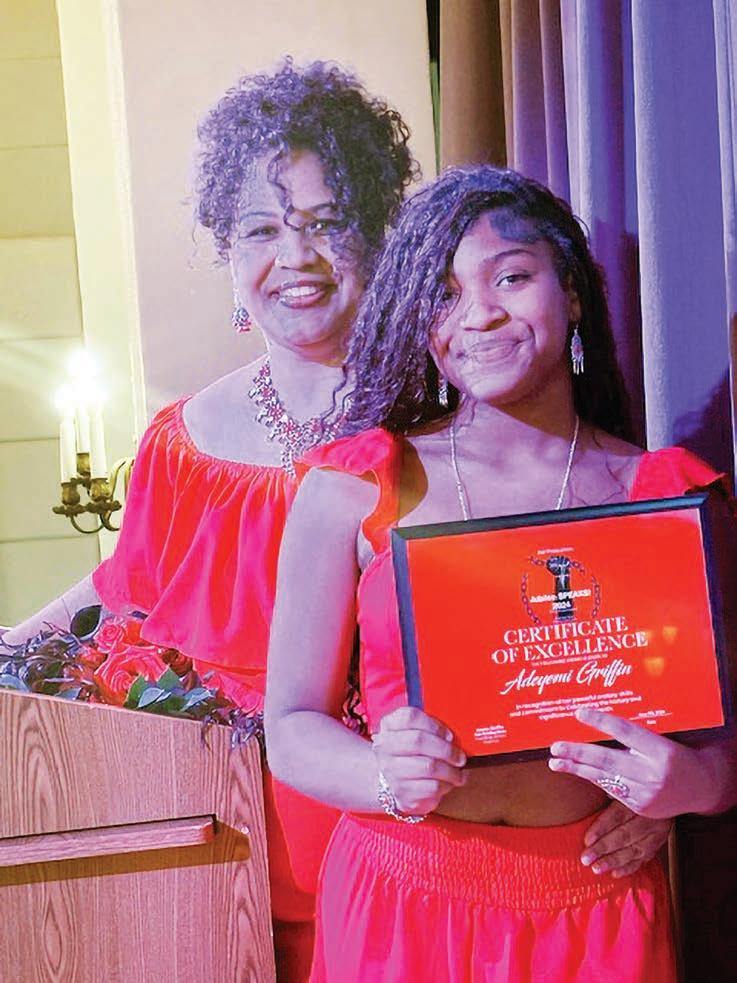
ern Style meal with specific significanc and i c BBQ chicken, c ollard greens with smoked turke y, oven-ba ke d macaroni and cheese, c oleslaw and honey ba ke d co rn bread we re pa rt of the menu. Ve g an options, red velvet ca ke, a special red drink and sweet tea we re also on the menu.
New Hope C ommunity Gospel C hoi r was pa rt of the performances. T he c hoi r sang songs of freedom directed by La Tonia Jackson during the luncheon.
G riffin p ulled the event of f with a bit of hard wo rk and suppo rt from f ellow CRC member Yo ko Te r etta and D97 School Board member Ve n us Hurd.
Fo r mer OPRF student Hasani C annon d esigned the T- shirts for the Vi llage of Oak Pa rk for the Juneteenth observ anc e, titled “F awohodie,” a 20x30 inch acrylic paint marke r o riginal drawing . Fawohodie re presents freedom and indep endence depicted as the g old X on top of the figure’s headdress. Malcolm X’s conviction to Black l iberation was also c entral to his inspiration.
Both state and locally elected officials we re in attendanc e.
“This was our first time doing thi s event,” G riffin said. “We hope to do it again next y ear.”
A ttendees we re also treated to a special rap performance by Oak Pa rker Ajani Griffin, Jauanta’s son.
A se’ Productions also org anized and hosts Oak Pa rk ’s Juneteenth C ookout and Parade.
“I j ust wanted to help suppo rt Juanta, ” Te r etta said. “She has an i nnate natur al vision for pr ogr ams the c ommunity need s. A lso, I f eel li ke with her vision fo r Juneteenth, she invites all p eople to the table wh ich is so important. My r ole is important only from the standpoint tha t ke at all r
Patenaude will take over for Merr y Beth Sheets
By AMARIS E. RODRIGUEZ Staff Reporter
Hephzibah Children’s Association has hired Jason Patenaude as the new chief executive officer.
His appointment is effective June 24. It comes after a nationwide search after for mer executi director Merry Beth Sheets announced her departure. Interim Chief Executive Nancy Dorfman Schwartz has been serving in the role since then.
Patenaude comes to Oak Park’s Hephzibah with three decades of experience leading nonprofits and for-profit or nizations, including serving as executive director and chie erating officer for the Schuler Education Foundation, where he worked to “support colle ge access for high-achieving, low-income, and under re presented students,” according to a statement.
Patenaude said he was looking forward to working with staf f and leadership at Hephzibah, because the mission is close and dear to his heart.
“As adoptive parents, my wife and I understand how enriching it can be to form a family through the kinds of foster and adoption programs that Hephzibah provides,” Patenaude said. “Also, as a multiracial family living here in Oak Park, we’re deeply committed to supporting Hepzibah’s contributions to our diverse and inclusi community.”
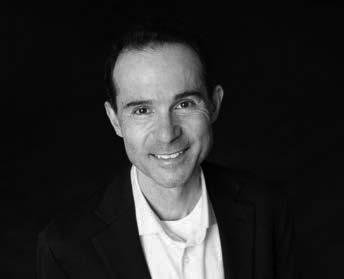
Patenaude also has worked as operating officer for Reading in Motion, a Chicago-based literacy organization, Cricket Media, a leading creaward-winning books and other products, and served as President of the Carus Publishing Company. He has a bachelor of arts deee from Bates Colle ge and a master of business administration de gree from Tuck School of Business at Dar tmouth Colle ge.


“Jason brings a growth-oriented mindset to the new role of CEO at Hephzibah and his extensive financial, fundraising and executive leadership experience at both for-profit and nonprofit organizations will undoubtedly enhance his stewardship of Hephzibah,” said Jennifer Ellis-Jason, board president.
Hephzibah is one of Oak Park’s oldest social service agencies, helping children and families through “innovative, communitybased programs,” which include therapeutic residential treatment programs for young children, wrap-around foster care services, and prevention services for families in crisis. They also run an after-school care and summer camp for elementary children in Oak Park
The Village of Forest Park has immediate opening for a responsible fulltime PACE Bus Driver to transport senior citizens, disabled residents and school children. Must have a valid Illinois Driver’s License, and a good driving record. In addition, must be physically fit and submit to criminal background check, annual physical exam and drug and alcohol testing.
M-F Days Starting salary $36,687 with excellent benefits. The position is a non-exempt, AFSCME union position.
Apply in person at Howard Mohr Community Center, 7640 Jackson Blvd., Forest Park. 708-771-7737.



















By LACEY SIKORA Contributing Reporter
When Sarah Coleman and Abe Chernin bought their Oak Park home in 2014, they knew right away that they were buying a home with an interesting history.
“The for mer owners were great stewards of the house,” Coleman said. “When we bought the house, they gave us everything that they had on the history.”
The C.H. Hill house was built in 1903 and designed by Patton and Miller, according to the information they received about their Georgian Revival-style home.
The couple learned that their new home had once served as a boarding house for men who worked at the Oak Park Club a few blocks away They also learned that their home had once had a wide front porch that spanned the width of the house.
Coleman said that it had always been in the back of their minds to restore the porch, but they first tackled more pressing renovations, like the kitchen.
A window of time finally opened up, and they turned to Oak Park architect Kim Smith to design a porch that looked like it always belonged
See HISTORIC PORCH on pa ge 20
from page 19
on their early 20th Century house
Smith came highly recommended by friends who had hired her to work on their historic district home in Oak Park. T he Coleman/Chernin home is also in the Frank Lloyd Wright Historic District so renovations on the front exterior needed to go before the village’s Historic Preservation Commission for approval.
“I didn’t have a strong sense of whether this would be a heavy lift with Historic or not. Kim was an obvious choice,” Coleman said.
that the commission reviewed the project in 2022 and “felt it was a fantastic restoration ef fort on a block with a lot of history.”
“We’ve seen a number of porch restorations, which are always great projects,” she said. “Usually, you can get a good understanding of the footprint from historic maps and draw on style details of the house. But this was a rare case in which the homeowners found a historic photo, which allowed them to re plicate many of the historic details like the paired columns at the stairs.”
“But this was a rare case in which the homeowners found a historic photo, which allowed them to replicate many of the historic details like the paired columns at the stairs.”
Smith, who was previously a member of Preservation Chicago and who has worked in Oak Park for 19 years, said her work is classically grounded, making her a natural choice to work on the area’s historic homes
SUSIE TREXLER
Urban Planner in Historic Preser vation for Oak Park
Her design for the new porch was based on a photo from the Oak Park River Forest Historical Society. Although the photo is not dated, there is some consensus that it represents the original design of the porch.
“You c an see that’s all we ’re doin g right now- p utting back wh at was there, ”
Smith looked to the historic photo to inform her choice of the ionic capitals used atop the columns. She also matched the original columns’ shape as best she could.
Both Coleman and Smith noted that this was one of the first times the HPC has approved the use of composite columns on an historic district home. Smith said the columns are “better for weather and longevity.”
Coleman added that beyond being more durable and more sustainable, the composite columns have another big advantage over wood columns.
“We have a dozen columns. It was going to be around $50,000 with an additional $5000 in delivery costs if we used wood It really opened things up for us to be able to use these.”
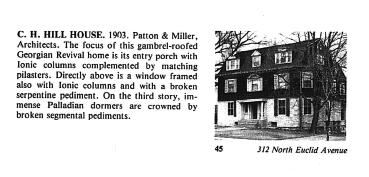
She also said she thinks the longevity of the composite columns will preserve the home’s historic façade for future owners.

“My understanding is that the reason so many porches aren’t around anymore is because they rot. We’re trying to be good stewards of the home and make sure it’s sustainable for the next f amily that lives here.”
During the construction process, which Coleman said has taken longer than expected, they hit some bumps in the road. Smith said there were soil issues, which are likely the reason the original porch failed. The construction work also uncovered some serious damage to the siding, likely from a fire in the 1930s or 1940s While remediating these issues prolonged the rebuilding of the porch, the end is in sight and Smith praised Cole-
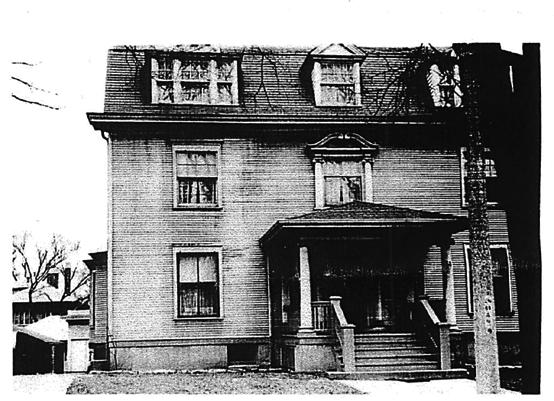
man and Chernin’s dedication to g etting things right.
“They’re just wonderful stewards,” she said. “We’re all here to be good stewards to these buildings that will be here long after we’re gone.”
Smith said she sees the HPC as a great partner in the work she does on historic homes and said that respecting the HPC process is vital.
“I’m a true believer. The rules are there for a reason,” she said.
“We have people coming from all over the world to see us. It’s because of our zoning and because of our landmarks. People want to see what’s here because of our historic housing stock.”
















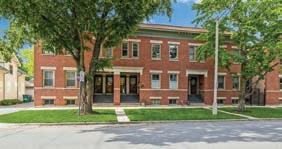

















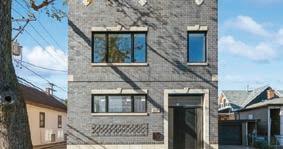







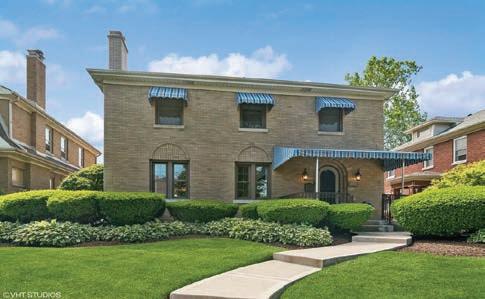

















































By KATHERINE FRAZER Contributing Reporter
The Black Aura: A Celebration of Black Liberation is set to take place this weekend at The Kehrein Center for the Arts to celebrate Black history, culture and artistry this weekend
From June 28 to 29, the event will host workshops, panels, a documentary screening, live music, and other events in celebration of Blackness on Chicago’s West side Local artists, musicians and poets will highlight their contributions all weekend.
Austin native Reesheda Graham-Washington is the founding executive director of The Kehrein Center for the Arts and the force behind The Black Aura. Graham-Washington said that her passion for Black justice and independence in Chicago
sparked her idea for a celebration near Juneteenth in the community
“The Black Aura is the weekend that will happen every year, the last weekend in June It is specifically and intentionally situated between Juneteenth and the Fourth of July,” Graham-Washington said. “It calls us to get present to what freedom and liberation means for us as individuals, and what does freedom and liberation mean for us in our cultural context.”
Community members can attend the event for free Friday, June 28, and participate in workshops and panels
“The first day of Aura will always be about teaching, learning, developing, and cultivating the community,” Graham-Washington said. “Those were experiences that we felt would be really important for the Chicago community to have access to, regardless of socioeconomic circumstances, which is why we made the first night a free event.”
Tickets for Saturday, June 29, are priced on a sliding scale. That night concludes with The Black Aura Awards Celebration Gala,
an awards ceremony that will honor four community members who are passionate about change and progress in the community, followed by music and revelry.
“To the extent that we will be educating ourselves and developing ourselves as we get present to freedom and liberation on Friday night, we will be celebrating ourselves and being in community with ourselves on Saturday night,” Graham-Washington said.
In the development of The Black Aura, Graham-Washington noted that celebrations for Juneteenth in Chicago varied greatly in how they took place. She looked to other communities for ideas about how to honor Juneteenth and Black heritage in her own community.
She said she drew heavily from the Dallas-Fort Worth area after connecting with Opal Lee, an activist from the area who fought to make Juneteenth a federally recognized holiday, who will speak this weekend. Seeing another community’s dedication towards Juneteenth inspired her Graham-Washington.
“I knew right away that I wanted to stay connected with the community of Dallas Fort Worth, because the holiday sort of is a manifestation of their vision of Juneteenth,” Graham-Washington said. “I wanted to make sure we were honoring that history and context. And from there, I started to think, Juneteenth is one day we should be carrying out these tenets of liberation and equity and justice and space and growth of humanity all year round.”
The Kehrein Center for the Arts, located at 5628 W, Washington Blvd., opened in 2019 before the start of the COVID-19 pandemic. Graham-Washington said that she hopes the Black Aura brings even more community members to the Kehrein Center.
“This is the inaugural experience of The Black Aura, and our hope is that the aura will catalyze people’s participation and attendance so that people start to know that we’re here,” Graham-Washington said. Tickets for The Black Aura: A Celebration of Black Liberation can be purchased on The Kehrein Center for the Arts’ website.
By KATHERINE FRAZER Contributing Reporter
Linda Francis is being reco gnized for her lifelong commitment to service and community improvement at this year’s inaugural Black Aura Awards Celebration Gala.
Taking place June 29 at T he Kehrein Center for the Arts, the Bridge Award honors Francis for her long-standing ef for ts to bring together neighboring communities Austin and Oak Park. The awards gala, which is the final event taking place at The Black Aura: A Weekend of Liberation & the Arts, highlights members of the community who enlighten Chicago’s West Side. T he Bridge Award is given to a member of the community that has dedicated their ef for ts to connecting communities through service, something Francis has done for decades.
Originally from New York, Francis moved to the Midwest to go to colle ge and
has sta earning a de ing at Nor she mo she has 30 year worked in a tions that allow her to gi back to her include serving in se roles Prevention Fund, as a pr director Forest founder of She also wrote an Wednesday T he award is part of a larger ef fort by community members to highlight Black history, ar tistry and culture on the West Side of Chicago. T he Black Aura: A Celebration of Black Liberation takes place on June 28 and 29 as part of a Juneteenthinspired art weekend. Francis said that
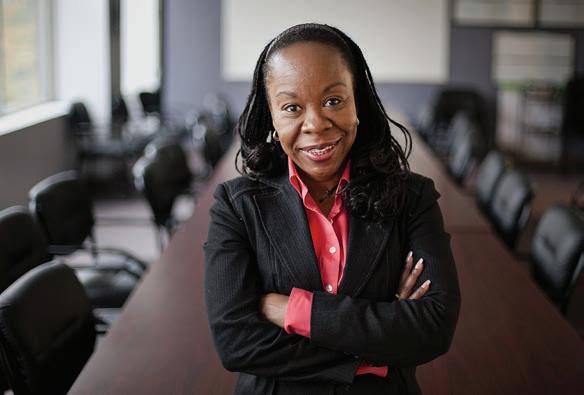
elebrating the experience of Black-Americans and the inetween those culors much of her caoman.
s a Black woman, I have often been in that space between who I am as a black woman and is needed in the larger said. “I used otten comfortable , being in that various groups, and I think that has helped me be in the pobridges and to make connections between institutions, people, groups that normally would not connect.”
Connecting Oak Park with Austin has been a large part of Francis’ mission, specifically focusing on bridging gaps within the two communities.
“Our neighbors in Austin, I think, think of us more than we think of them,” Fran-
cis said. “I think we need to take note of that. I am so honored that they thought about the work that I’m doing, or that I have done, and thought to include me in the group of recipients for this first year of honors, and I think that it’s important for us to also show that connection and acknowledge that connection that we have to our neighbors.”
Francis said that the neighboring community in Austin is important to her. She said that as a resident of Oak Park, it is important to her to extend a hand and think of other communities when possible. For Francis, much of the work is done when considering what outcomes decisions have for these communities and advocating for the most favorable ones
“Although we are separated for governing and taxing purposes, it’s only a matter of crossing the street in any directio n that puts you in another community,” Francis said. “Ther e’s so much more that we can be doing if we work to g ether.”
DEADLINE FOR SUBMISSIONS IS FRIDAY 5 P.M.
ktrainor@wjinc.com
Afew days after village trustees renewed the highly controversial Flock license surveillance cameras, Oak Park political activists gathered for their monthly conversation. Much of the dialogue centered on the surveillance decision and other village decisions — including, of course, more head-scratching and anger around leaf-bagging.
A leading community member, in summing up the evening, noted, “We can’t have increasingly un-democratic processes in our town as the broader country slides toward fascism.” At the heart of that perspective, I believe, is a widening gap between Oak Park trustees’ professed values and their actions around democratic gover nance, transparency, and racial equity.
The three examples I share here are emblematic of the growing disconnect between needs expressed by the community, often eloquently articulated by citizen commissions, and decision-making by most of our elected leaders.
On April 9, as multiple ceasefire supporters readied to make passionate, heartfelt pleas to place the Oak Park ceasefire resolution (1) on the agenda for a future meeting, President Vicki Scaman, before any public statements were made, proclaimed that trustees had already unanimously agreed to not support or even discuss the resolution. The democratic dialogue at a future board meeting that all had expected, shockingly, was blocked from consideration. It seems the board violated the spirit, if not the letter, of the Illinois Open Meetings Act. Trustees had an important dialogue and agreement in private and, despite persistent requests since then for an open discussion and debate, that is where it remains.
The Flock decision on June 4 widened the accountability gap with village decision-makers, further under mining transparent gover nment and their commitment to racial equity in two ways: The village administration refused to include in the agenda the Citizen Police Oversight Committee (COPC) 11-page report (2) proposing cancellation of license surveillance. CPOC is the community body tasked with studying this issue, and yet its data and value-rich report was not included in the board packet for background to their vote. Among other things, this report showed that, despite police not conducting one license-generated stop for the last four months, the data revealed striking racial disparities, including unacceptable error rates Sadly, we also learned that evening that Village Manager
IShrubtown: The real purpose of Flock cameras
really didn’t start thinking about “community” until I went away to colle ge But I had experienced a particular kind of community before then, during my upbringing in Berwyn. And as I studied, practiced and wrote about community the decades, my understanding of richer and more nuanced, shaped ferent stages of life, exposure to literatur of smart people, and the circumstances unique to the places in which I lived.
I first got fired up about community at the Newman Center, next to SIU’s campus in Carbondale. There, exposed to inspired liturgy and the writings of Teilhard de Chardin, community became something emerging around us, powered by God’s love, moving ev lution forward toward better for ms of human organization.
That progressive notion of Chardin’s contrasted with the stable, somewhat defensive orientation of the neighborhood I had grown up with. My boyhood community in the ’60s and early ’70s was largely Catholic, white and traditional with respect to men’s and women’s roles. It included many good folks on the nearby blocks, but it was not a community pressing to In fact, with the racial inte ’70s, Berwyn took a decidedly more defiant and restrictive stance toward it than did Oak Pa
The inspired theological view of community that I acquired in Carbondale moved me to pursue a graduate de gree in community development. As I have written before, that training would include helping Oak Park as an intern with its ef for ts to embrace inte gration

[Peeling back the layers of racial bias, Viewpoints, June 18, 2020].
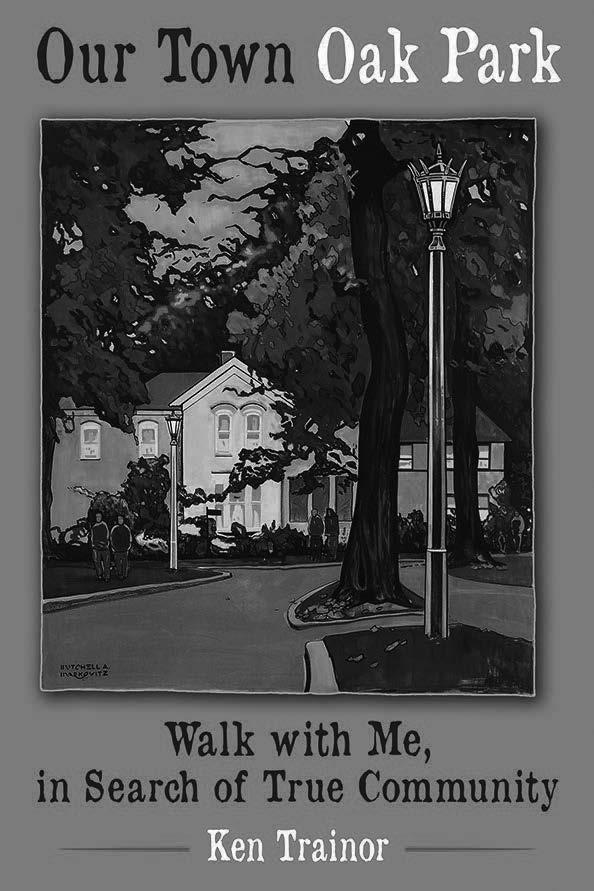
Post-master’s de gree, I practiced community development in Pennsylvania and Indiana. Then, I pursued a doctorate in Political Science, with an interest in understanding rked against and good communities. I studied a neighborhood in Indianapolis, examining and below” that created different kinds of neighborhood institutions: a health center, a community organizing group, an economic development organization, and a multiservice center. My studies exposed me to communitarian writings that extolled the importance of building on shared values, a common history, mutually embraced goals and fection for a place. I also learned and taught urban political theory that unpacked power namics and conflict as they occur red in neighborhoods. And then came a jolt to my understanding of community: I became a father. Through the lens of fatherhood, I came to see quickly how organically tied as a family were to the community, in and the neighbord. Those natural links between our family’s functioning and the community’s viability quality depended in very specific ways on how we parents handled our roles, and the kids’ growth depended on the community’s diligent nur turance.
These are perilous days at the Oak Park Regional Housing Center. Oak Park’s village government, which has partnered with the Housing Center and supported it financially since its founding 52 years ago, is debating whether to continue funding it, a result of the nonprofit agency’s financial missteps — mismanagement, not malfeasance.
Back in 1972, the Housing Center was Oak Park’s most audacious effort to intentionally nurture a racially diverse housing market at a time when integrated communities simply did not exist in America.
Read that back. In the early 1970s, there were no racially integrated communities anywhere in the United States. There were neighborhoods in rapid transition from being all white to being all Black. There were a handful of suburbs, such as Evanston, that had a Black community fully segregated from the majority white community.
But there were no villages or towns which chose, which consciously acted, to become integrated racially. Oak Park, facing the block-by-block resegregation of the West Side, made that bold choice. The Housing Center was founded to maintain white housing demand, especially for the 50% of housing units in Oak Park that were apartments. The goal, effectively, was to steer white apartment seekers toward apartments on Austin Boulevard and Washington Boulevard while urging Black people toward apartments on Maple Avenue or Harlem.
Controversial? Yes. Effective? Yes.
That program, now called Live in Oak Park, has continued over the decades. There have been legitimate questions about how the effort has adapted, or not, to the online apartment rental world. It will now be shut down, given the elimination of Oak Park funding, says Athena Williams, the agency’s director
Here’s the core issue: It is easy to take Oak Park’s racial integration for granted. But that is a mistake. Oak Park is strong and it is fragile. There are still forces at work that discourage integration, and Oak Park needs a steady effort to respond
We understand the village’s deliberation, although the village is not blameless in this rolling debacle. But where is the conversation about intentional support for diversity and integration? Just as the Housing Center must do some soul-searching, so must the village board. What efforts will Oak Park stand behind in 2024 to maintain and grow this core aspect of our community life?
Last week and this week we have published letters critical and supportive of a recent Shrubtown editorial cartoon by Marc Stopeck.
The panel intended to focus on concerns expressed publicly by Percy Julian Middle School teachers over issues of safety and student behavior at the Oak Park school.
The issue is legitimate and longstanding, the school district has done an inadequate job addressing it, and it has failed to talk plainly about the complex issues.
That said, we side with critics of the comic who believe the cartoon missed its mark. In criticizing the school administrators and the school board, we believe the cartoon, instead, also pointed at students, including some young migrant students, at Percy Julian.
We are proud to have published Shrubtown for 33 years and believe it is the best local editorial cartoon we’ve ever seen. At the same time, we acknowledge it fell short of our standards, and we apologize. We will work to do better
I first wrote about a Festival Theatre production of “Romeo & Juliet” back in 1993 and have since seen two other productions in Austin Gardens. This summer’s performance, which begins July 5, will be the fourth. I never tire of the play and its extraordinary language. The following piece, “Festival Theatre: A star-crossed night,” can be found in my book, “Our Town Oak Park – Walk with Me in Search of True Community,” in the Settings chapter on page 146, one of 90 short essays capturing “community” in this village. The book is available at The Book Table, 1045 Lake St.

In some parks you play ball or barbecue or run your dog or toss a frisbee. And then there are parks like Austin Gardens, where, for six weeks each summer, Shakespeare’s players strut and fret their hours upon a temporary stage. Think of it as Stratford on Forest Avenue
Normally, this is a place of repose — part woods, part meadow, circled by a paved walkway. There’s also a gravel path through the wildflowers (in spring) among the trees on the north end This is about the last place you’d expect to find impassioned soliloquies, desperate swordfights, and star-crossed lovers, but that’s what’s in store on this muggy evening for the 100 or so spectators who have staked their turf with lawn chairs and blankets, forming an expansive semi-circle that fans out from the wooden stage
Four tall erector-set towers roughly define the parameters of the seating area. A cluster of lights perch on top, aimed at the stage below. A cat’s cradle of wires connects the towers, and ground cables wind like snakes through the grass.
This summer’s scheduled Shakespeare al fresco is Romeo & Juliet, courtesy of Festival Theatre, which has been doing this for over four decades, but that fearful consequence hangs in the stars, which won’t be visible until dusk thickens into night. At the moment, wine and cheese and full-blown picnics are currently the centerpiece. Salami, crackers, and fluted glasses form lovely still-life arrangements atop wicker baskets, short-legged tables, and plastic coolers.
Petunias in window boxes decorate the skeletal stage, which will shortly serve as a villa, garden and Verona’s town square. “I’ll bet I know where Juliet stands,” observes one sharp-eyed patron d’art, pointing to a balconesque construct to the right. A man wearing a blue Festival Theatre Tshirt interrupts consumption and conversation, in medias res, to beseech the audience to fill out their surveys, necessary for future grants. They need to know how often we attend live theater, how much money we make, and how much time and how many dollars we’ve spent
in Oak Park as part of our “theater experience.” Don’t forget babysitting charges. You can see where all this is heading, but in the current economy, one can forgive an arts organization its sense of urgency about hustling funds.
As dusk deepens, the thicket of trees behind the stage seems to close ranks and creep forward like Dunsinane Wood (but that’s another story). Renaissance music flows from the speakers on either side of the stage. The heavy, drapery-like costumes can’t be comfortable on a sultry night like this.
She doth teach the torches to burn bright. … she hangs upon the cheek of night … beauty too rich for use, for earth too dear. … Did my heart love till now? Forswear it, sight, for I ne’er saw true beauty till this night.
Lights bathe the set, accented by sporadic fireflies and heat lightning to the north, providing an appropriate backdrop to the charged atmosphere of ancient grudge and bloody mutiny that is the business of our next three hours.
The stage itself hangs upon the cheek of night, the beauty of the language too rich for use, for earth too dear. The brightness shames the stars as daylight doth a lamp, so bright that birds sing and think it were not night. By whose direction did we find this place? By love, that first did prompt us to inquire. He lent us counsel, we lent him our eyes
In the front row, two young gentlemen (not from Verona) invite two young ladies to combine blankets with them. Perhaps more stars will cross this night than the doomed duo onstage
The actors speak their speeches trippingly from the tongue (yet another story) while, along the wester n edge of the park, lit windows of a condo building remain open, perhaps to catch this midsummer night’s livestream dream.
Overhead, an occasional phantom aircraft crosses the Big Dipper like some evil omen. As if on cue, the fortunes of our two heroes take a decided tur n for the worse. There never was a tale of more woe, but the crowd doesn’t seem bummed. Their applause, though muffled by the great suburban outdoors, is appreciative, in spite of the decidedly downbeat ending.
What a civilized way to spend an evening in the village’s most civilized park. The audience lingers afterward on the green meadow, nailing down vacation plans, finishing drinks, packing coolers, and, finally, strolling off into the star-crossed night, swearing by the moon, or by Shakespeare’s gracious self, which is the god of our idolatry.
“Romeo & Juliet,” Festival Theatre’s 2024 production, begins with previews on July 5 and runs through Aug. 17 onstage in Austin Gardens.

I am not a frequent attendee at village board meetings (perhaps two or three in my 20+ years living in Oak Park) but I attended the June 18 five-hour marathon meeting.
I was very impressed with the very thoughtful and nuanced approach when dealing with the issues re garding the Oak Park Regional Housing Center. The respect for that organization’s accomplishments, the patience and devoted work to help that organization by the staff and board members over a number of years is commendable. But the lack of accountability and consistent lack of timely/accurate reporting/transparency and loss of HUD status justified the need for a change in the village’s ongoing support. The in-depth discussion of their mission and how it can be accomplished in today’s Oak Park was also very thought provoking
I wish I could say the same about four of the board member’s approach toward the approved change in leaf collection. This change in policy seems to lack patience, accountability and transparency. This change was pushed through in a short time without much public interaction. And while it is not the most important issue in the village, it is one of the things that brings people to Oak Park — the trees.
Change in how we care for trees should be well-
planned and thought out. Will the need to bag leaves or stuff them into garbage cans change peoples’ attitudes toward continuing to support a large stock of trees? I do not know.
Neither does the village. When staff was asked if the village could go back to the old way of street collection, they said it would be cost prohibitive as our contractor had already lost access to the equipment needed to fulfill our needs.
Really? LRS has already moved on? I find that hard to believe. And the discussion of rebates, assistance for the needy, total cost of bags — not just the $.50 but the environmental impact of more paper, more glue, more waste — is not completely understood
I applaud President Scaman’s assessment of the situation when implementing change of this type: “Consensus is required.” The village does not have the consensus of its constituents on this topic.
It is a shame that both important issues could not have been handled in a similar fashion.
I truly thank you for your efforts to continue to improve Oak Park
Steven Kastenholz Oak Park
of Oak Park and River Forest
Editor Erika Hobbs
Digital Manager Stacy Coleman
Sta Repor ter Amaris E. Rodriguez, Luzane Draughon
Viewpoints Editor Ken Trainor
Real Estate Editor Lacey Sikora
Digital Media Coordinator Brooke Duncan
Columnists Marc Bleso , Jack Crowe, Doug Deuchler, Mary Kay O’Grady, Kwame Salter, John Stanger
Shrubtown Cartoonist Marc Stopeck
Design/Production Manager Andrew Mead
Editorial Design Manager Javier Govea
Designers Susan McKelvey, Vanessa Garza
Marketing Representatives Lourdes Nicholls, Ben Stumpe
Business & Development Manager Mary Ellen Nelligan
Circulation Manager Jill Wagner E-MAIL jill@oakpark.com
Special Projects Manager Susan Walker
Chairman Emeritus Robert K. Downs
Publisher Dan Haley

BOARD OF DIRECTORS
Chair Judy Gre n Treasurer Nile Wendorf Deb Abrahamson, Gary Collins, Steve Edwards Darnell Shields, Sheila Solomon, Eric Weinheimer
Our mission is to lead educated conversation about the people, government, schools, businesses and culture of Oak Park and River Forest. As we share the consensus of Wednesday Journal’s editorial board on local matters, we hope our voice will help focus your thinking and, when need be, re you to action.
In a healthy conversation about community concerns, your voice is also vital. We welcome your views, on any topic of community interest, as essays and as letters to the editor. Noted here are our stipulations for ling.
Please understand our veri cation process and circumstances that would lead us not to print a letter or essay. We will call to check that what we received with your signature is something you sent. If we can’t make that veri cation, we will not print what was sent. When, in addition to opinion, a letter or essay includes information presented as fact, we will check the reference. If we cannot con rm a detail, we may not print the letter or essay.
If you have questions, email Viewpoints editor Ken Trainor at ktrainor@wjinc.com.
LETTER TO THE EDITOR
■ 250-word limit
■ 500-word limit
■ Must include rst and last names, municipality in which you live, phone number (for veri cation only) Email Ken Trainor at ktrainor@wjinc.com or mail to
■ One-sentence footnote about yourself, your connection to the topic ■ Signature details as at left
■ ONLINE w ww.OakPark.com
Wednesday Journal is published digitally and in print by Growing Community Media NFP. The newspaper is available on newsstands for $2.00. A one-year subscription costs $52 within Cook County and $72 outside of Cook County
NFP.
Ihave to react to Steve Gevinson’s OneView [We ag ree on the need for discourse, Viewpoints, June 5]. What else can I do? He called me (and Caren Van Slyke) “deceptive and otherwise unscrupulous.” I have to unleash self-defense, don’t I? Like Israel, I have to re-establish dominance over (journalistic) real estate. I must remorselessly pound rivals into oblivion. Right?
So, to commence the responsive barrage … Steve again war ns the Oak Park Village Board not to risk the slippery slope of public engagement outside its jurisdiction, even helpfully identifying over three dozen unrelated subjects he deems beyond the board’s ken.
Actually, the board has already addressed the very first issue on Steve’s list — guns, as recently as last year [1]. Then there was the Welcoming Village ordinance in 2017, responding to the national immigration debate [2]. A pedant might object that those were ordinances, not resolutions, but I would deceptively re ply that ordinances, being enforceable, are even stronger statements of community commitment. The more meaningful principle here is that the board can and should act, using mechanisms appropriate to the circumstances, when the public demands it.
Steve would seem to ag ree. He says our government entities provide “ways to resolve conflicts fairly and without violence.” (If only the Israeli government, which Steve aptly describes as “by far the
worst government in Israel’s history,” also ag reed.) Isn’t our disagreement about a ceasefire resolution, exactly a call to proceed without violence? But instead of the resolution, Steve recommends “education and civil discourse.” OK, I’ll take those disingenuous recommendations disingenuously. The resolution’s proponents, and the overwhelming majority in our progressive village, have been educating themselves since last autumn and now want the mass slaughter (and starvation and utter destruction) in Gaza stopped. As for civil discourse, aren’t we — Steve and I and Caren Van Slyke and many others — civilly discoursing on paper? Haven’t the pro-ceasefire demonstrations been entirely peaceful, with virtually no police presence? And why should any of this postpone a call to ceasefire?
One View
Because, lacking substantial community support, delay is the point of Steve’s recommendations. Because if more of the “89,004 local governments in the U.S.” (Steve’s research) were to insist on a ceasefire, there would be more pressure on federal decision-makers to halt weapons deliveries to Israel. Delay is Israel’s enabler, so it can finish its maximalist job. And even more disingenuous is the “education” ploy. Education is Steve’s euphemism for expanding support for Israel. But while that support flows from the one-sided tribal teachings we both received as Jewish youth, the actual history
While I agree with Phyllis Rubin’s letter, “How do we show we care about both sides?” [Viewpoints, June 12], I also believe that there is a third, powerful side — Hamas.
Most of the media has neglected to discuss Hamas. However, in the Sunday New York Times, June 12, the front page has the heading, “Gazans Voice Their Distress Under Hamas,” which presents a 47-year-old Gazan man who stated, “Hamas always acts in its own interests. It started Oct. 7, and it wants to end on its own terms. ... Hamas is still seeking its slice of power” (since it seized control of the territory in 2007 and
ke pt its people impoverished and captive).
“Hamas does not know how to get down from the tree it climbed.”
Other Gazans who spoke to the Times claimed that Hamas knew it was starting a devastating war with Israel that would cause heavy civilian casualties, but it did not provide any food, water or shelter to help people survive it.
Therefore, let us include Hamas’ treacherous role when we all discuss ways to peace in the Middle East.
Hinda Blum Oak Park
of Palestine-Israel disgraces Israel.
Steve also incorrectly says I attribute “Israel’s actions to one motive: vengeance.” Nope again. I also attribute Israel’s actions to a determination to seize land and resources in Gaza and the West Bank [3], to a drive to restore its regional dominance [4], to an intention to minimize and enclose the Arab population [5], to an embedded fear of Jewish annihilation, to a post-Holocaust expectation of unique status, and to the political and messianic ambitions of Netanyahu and his cronies [6]. Israel promotes only itself. As Steve himself puts it, “people are competitive by nature and will always have conflicts.” Israelis are people. What I don’t attribute Israel’s actions to is the noble mythology that virtually every group ascribes to itself.
Finally, Steve claims I intended a “slur” when noting he’s a for mer educator. Nope. Didn’t. Wouldn’t. Our son’s a third grade teacher on the West Side. I was a teacher in my much younger years. The “slur” I did intend (and I suspect Steve actually knows this) is that he fails to meet the standard of unbiased analysis I expect from a competent educator. On this particular subject, that is. More generally, I respect Steve’s history as an educator. But let’s not lose sight of what we ’re discussing. A ceasefire. Gaza is pulverized. Its people are hungry and homeless, sick and wounded. Or dead. Its remaining
fighters survive through underground bunkers. The only Israelis now at risk from Gaza are in Gaza, making war on everyone and everything. And presumably no Israelis will again allow their ar ro gant, self-serving leadership to ignore clear warnings [7]
There’s no justification for more killing. Period. So I urge my co-villagers, as deceptively and unscrupulously as I can, to add Oak Park’s voice to the ceasefire chorus.
[1] www.oak-park.us/newsletters/ novemberdecember-2023/safe-storagefirearms-required.
[2] www.oak-park.us/our-community/ community-relations/welcoming-village [3] www.newarab.com/analysis/israelsets-its-sights-gazas-offshore-gas; www. foreignaf fairs.com/israel/israels-annexation-west-bank-has-already-begun; www. france24.com/en/middle-east/20240326israel-s-largest-land-seizure-sinceoslo-accords-deals-fresh-blow-to-palestinian-statehood
[4] www.israelhayom.com/2024/01/23/ winning-is-incomplete-without-deterrence/
[5] cnn.com/2024/01/17/middleeast/ israel-far-right-gaza-settler-movementcmd-intl/index.html
[6] www.newyorker.com/magazine/2024/01/22/benjamin-netanyahuisrael-gaza-hamas-war-hostages [7] www.nytimes.com/2023/11/30/ world/middleeast/israel-hamas-attackintelligence.html
Marc Stopeck’s cartoon [Viewpoints, June 19] powerfully highlighted le gitimate concer ns about safety issues at our middle schools. The time and energy of District 97 administrators would best be spent getting to work on addressing the safety concerns brought up by middle-school parents and teachers, rather than constructing a letter that deflects attention by raising spurious concer ns about the car toon being xenophobic and dehumanizing to students.
Robert Marshall Oak Park
In response to the insightful and biting Shrubtown cartoon and subsequent letter [“Our students are not cartoons” https:// www.oakpark.com/2024/06/18/ourstudents-are-not-cartoons], over the past several years many comics, satirists and humorists became timid for reasons that are well documented and understood Organized social media mobs are real. By saying the “wrong” thing, you could ruin your career, lose “friends,” and worse. That pullback from such artists was clearly detrimental to public discourse and has negatively impacted society overall. That somewhat dark period seems to be ending as comics, satirists and humorists are back Thank goodness Mr. Stopeck, using intellect and wit, did exactly what brilliant cartoonists do. They make us think. They make us pause. They make us chuckle. They make us a little uncomfortable. They make us want to discuss
and get engaged in issues that we care about. In shar p contrast, District 97 leaders took the un-nuanced low road in their response. D97 leaders, in describing a cartoon, and Mr. Stopeck personally, used such phrases as “xenophobic stereotypes” and “he dehumanizes immigrants and our students.”
schools have been a beacon of community collaboration all along and that the district is simply increasing “clarity” and “aligning systems.” Rather than owning policy failures and laying out serious course corrections, the letter resorts to browbeating and empty edu-speak.
D97, you are simply missing the point.
The cartoon was a critique on the school culture, environment and resulting “system” that the adult leaders have created. I don’t believe Mr. Stopeck or our community is placing blame on students. It took brave teachers to speak up and alert the community to the real challenges that are now playing out in our schools in hopes of helping, not blaming, our students.
And yet D97’s response is to somehow try to silence Mr. Stopeck and suggest our
In the WJ letter, our school leaders, reaching out for support that they now understand is somewhat fading, “invite everyone … to visit our website, which includes a gallery of photos from this year that captures our amazing students as they lear n, grow, and are joyful together.” While I am certain there are many wonderful things occurring in our schools every day, the teachers’ description of the day-to-day school culture was less joyful and more concerning. Community members are simply going to trust hours and hours of teacher and parent
T he River Forest Board of Trustees met on June 17 to vote on the ZBA findings. The meeting was a real love feast even though there was no food available. The president and the trustees showered the residents with unending praise for their ef for ts to overtur n a petition that the village itself wanted approved. It was dif ficult for me to reco gnize the board’s president and trustees as the same persons who for many years ignored the comments of any resident opposing the petition to modify the zoning.
I wondered: Are these trustees the same people? Why did they change their attitude so drastically? Was it the result of a collective e piphany?
T he behavior of the president and trustees, their patronizing attitude toward the residents, and their utter belief that we are nothing but a bunch of nincompoops with no memory of their past decisions is somewhere between comical and insulting
T he president insisted that this is how the system works: there is a proposal, the proposal is discussed by the appropriate board/commission in front of the residents, and the trustees make their decision based on the recommendations of the board/ commission. As the president said to me, the board trustees listen to the recommendations . Unless of course when they do not, and this process is completely ignored.
Here is an example, not to rehash the past, but to emphasize the lo gical coherence and trustworthy rationality of our village president.
Copied and pasted from page 3 of the transcript
of the March 13, 2023 meeting:
“President Adduci invited Dr. Nucifora up to the podium to give public comment re garding the traffic installations in the Northeast portion of town. Dr. Nucifora asked if the villa ge has already decided that the traffic installations will become per manent. President Adduci stated yes and the projects have been budgeted fo r.” (https://www.vrf.us/uploads/cms/documents/events/VBOT_Packet_Compressed_04-10-23.pdf)
I still do not understand why Ms. Adduci said that, given that the board had not voted, that no money had been approved for the work, and given that at least one professional study had nixed the plan.
So I do not know whether the president and the trustees pretend, do not listen, or whether they really do not know what they are doing. No of fense intended here, but the trustees and the president are not experts on zoning, traf fic, planning, or any issue that arises in the village. They all are residents as are those who disag ree with them. Equal residents. T hey have been elected to re present the residents and to work in the residents’ best interest. They are not obligated to do it, but if they accept to do it, it should be with full understanding of what they are doing and in the best interest of the residents, not in the best interest of one of them.
Please be honest and consistent with us.
Giuseppina Nucifora River Forest
public comments over a gallery of carefully curated photos for a sense of the truth.
Leaders owning up to their actions without misdirection and victimhood — now that would be both funny and newsworthy in a weird 2024 kind of way. I can see another cartoon coming. I can’t wait because humor is a sign of a healthy and enlightened society We all should be able to — I submit we must — interject humor into serious issues with the goal of spurring discussion and finding better solutions.
Maybe our middle-schoolers should take classes on the historical role of satirists and the benefits of true debate. That is, if there is any time left after the walkouts, lockdowns, peace circles and class interruptions Too soon? O just a just a little uncomfortable?
Ross Lissuzzo, a proud graduate of Hawthorne Junior High, now known as Percy Julian Middle School, is a resident of River Forest
Late last summer I wrote a letter, published in Wednesday Jour nal, recounting the story of my daughter, Maggie Daly Davis. She was on a Back Roads bike trip in Croatia last July She was hit by a car while biking and suffered severe injuries, including a broken tibia, a neck fracture, a skull fracture, and a brain bleed. If she had not been wearing a helmet, Maggie would have had brain damage or could possibly have died. She has completely recovered thanks to surgery, physical therapy, and deter mination. But her recovery has taken almost a year.
My friends, neighbors, and I have noticed how few, mostly middle-school-age children but also adults in our communities, are not wearing bike helmets. Recently I saw a boy riding his bike down the middle of a street in River Forest not wearing a helmet, not holding the handlebars, and staring at his phone. This behavior has become all too common. My informal survey while walking or driving is that 3 out of 4 people are not wearing helmets.
Bike accidents can happen anywhere, but severe injuries can be prevented. It is my sincere hope that parents will insist that their children wear a helmet, and that the adults in our communities will set a good example by donning a helmet themselves.
It would be beyond tragic if anyone were to lose their life or be badly injured because they weren’ t wearing a helmet.
The June 18 online edition of this publication re ported on the June 17 meeting of the River Forest Board of Trustees wherein the board affirmed the findings of the ZBA re: proposed text amendments
“The surprise action supports vocal opposition by residents.”
T he sur prise is rooted in the flawed so-called “process” and the dysfunction of a board that rewrites methodology at the drop of a pin and hides the ball from its peers.
The Process: The village hired and paid serial village planner John Houseal to draft amendments to current zoning to permit high and dense residential housing in commercial districts.
The village president described this proposal variably as a “clarification” and “simplification” of existing zoning.
In her Letter to the Editor in support of rezoning, “Nothing to fear from zoning updates” (Wednesday Jour nal, April 10), the village president wrote:
“What we are doing is reviewing codes that have not been changed for three decades. We are doing the work to diligently review the way our codes are written, to ensure that River Forest is a place people want to live, raise a family, work and play.”
The Hiding: On June 17, the president and several board members suddenly characterized the zoning amendment process as merely an “exploration and discussion,” causing Trustee Brennan to state that she had “whiplash.”
River Forest citizens were never infor med at any time that the proposed rezoning was merely an exploration and discussion of ideas. The board’s position was to recodify River Forest zoning, as it was communicated time and again at every meeting and hearing and in village publications Surprise is further rooted in the blatant appearance at the board table on June 17 that at least two trustees were well aware
Because it relates to the leaf-bagging issue, we’re reprinting a Viewpoints essay which originally ran on Oct. 1, 2013 and was updated on Feb. 10, 2021:
According to the Oak Park Public Works Department, the village annually collects an average 2,850 tons of leaves at a cost of about $193,000. That’s a lot of leaves and money (not to mention a lot of leafblowers). Then we individually spend more money and consume more fuel purchasing and transporting fertilizer and mulch, not to mention the production and packaging of the fertilizer and mulch.
There is a more sustainable and ecologically-minded solution.
Instead of blowing or raking leaves into streets, we could consider keeping some if not all of the leaves for many reasons By keeping the leaves in our yards, we improve our soil as earthwor ms and other organisms break down the leaves and naturally fertilize the soil, creating a better environment for our plants. Having a high diversity of soil organisms enhances water penetration, and many of these organisms
of the flipped position, while other board members were unaware. Certain trustees echoed the village president word-forword, almost as though they rehearsed the night before in someone’s basement.
Revisionist History: The June 20 River Forest Village Newsletter Commercial Zoning Update stated:
“On November 17, 2023, the board unanimously voted to direct village staff to explore and discuss potential changes with the zoning board.”
This “explore and discuss” narrative is false. The village board never once “explored” or “discussed” the proposed zoning amendments — not even at the board table on June 17, when the narrative was radically redirected
While we are relieved the board rejected the proposed rezoning, we are dismayed at the abuse of the process
What remains hidden behind “the drawing board?”
decompose what would become pollutants and also contribute to improved air quality
Healthier soil results in healthier plants, more able to fend off various stresses. If we stockpile the leaves, then we also have free mulch next year to continue to improve the soil, increase water retention, and regulate soil temperatures Leaf mulch in the garden or around shrubs and trees acts like a sponge, so during times of high rainfalls, the leaf layer absorbs the rain and allows the rainwater to percolate more slowly through the soil instead of into the sewer system.
One View
Birds tur n over the leaf layer, searching for food and enjoy the increased insect population in the spring as the overwintering insects complete their life cycles — 95% of birds feed insects to their young, and with the increased pressure on birds and nearly all species of animals, we should strive as a community to compensate for their habitat loss We need to recognize that an increase in biodiversity is good for sustainability, an initiative that many Oak Parkers support
What can River Forest constituents expect next when the entire zoning and potentially subsequent development process is neither accurately communicated nor followed and constantly in flux?
We are the neighbors of South River Forest. We are joined and united by neighbors across and along the entire village, from Madison to North Avenue, from Thatcher to Harlem.
As Trustee Brennan observed, we worked endlessly for years to be heard and to communicate the village activities to the vast majority of constituents unaware of the proposed rezoning. We were held hostage by never-ending gaslighting, pulled away from our jobs, our families, our homes, and our sleep, sacrificing our hard-ear ned money, our weekends, and our vacations
In retur n, we are rewarded with a Trojan Horse of revisionist history as we approach the next election season.
Deborah Borman is a resident of River Forest.
Another little-known benefit to retaining leaves is that most of our butterflies, native bees, and other insects overwinter in the leaf litter or garden debris. Most butterflies and moths (including those beautiful Luna, Cecropia, and Polyphemous moths) spend their time as caterpillars or as pupae during the winter. Allowing the leaves to remain in the garden or in a pile will likely help to increase our native insect population, many of which are important as pollinators.
The amount of leaves dropped can be overwhelming, and we do have small yards, but it is possible to keep the leaves. Last year my family was able to retain most of the leaves from our 80-plus-year-old Norway Maple, as well as all of the other garden debris in our very small yard. We simply put the leaves under bushes (away from the trunks), in an area for passive composting, and on the garden beds.
In the spring, the piles had reduced dramatically from a height of 18 inches to an inch or two. By July, I was wishing I had
more leaf mulch and collected leaves from parkway trees that were dropping leaves to cover the bare soil in my gardens. All of the soil beneath the leaf mulch is loose and rich thanks to the sizable earthwor m population, as well as the rest of the under-appreciated millions of decomposing organisms
Another strategy for dealing with the volume of leaf litter is to simply mow over the leaves and leave the leaf mulch on your lawn. It’s a simple and inexpensive way to build a healthier lawn.
Keeping the leaves in the yard is a fairly simple and easy thing to do to benefit ourselves and our pocketbooks (no need to pay for fertilizer or for mulch). It reduces the burden on the village with associated decreases in pollution and oil consumption. Creatures benefit too: butterflies, bees, and other beneficial insects. It’s a sustainable thing to do, resulting in increased beauty and a healthier ecosystem we all share.
For those interested in soil organisms, visit this Soil Biology Primer: http://soils.usda. gov/sqi/concepts/soil_biology/soil_food web.html
By MAUREEN CONNOLLY Author
In a writing exercise to create two diverse individuals, I imagined a wounded physician and a café owner trying to become pregnant by artificial insemination. Theirs became the main story of my new novel, A Million Miles from Yesterday As a physician, my medical experiences — some sad, some hilarious — informed this novel. The town doctor in Alma, Wisconsin, Hank Cleary, failed his wife when she died. He’s numb from grief and medical training. He struggles to climb back into life. Will he forgive himself? Will he confront himself in new ways? Where does courage come from?
A Chicago expatriate, he is challenged by other migrants: the Chicana owner of Livy’s Bar and Café, an old man who loves jazz, a Navajo f amily transplanted from the Southwest, a strange woman who rarely speaks, a drifting Menominee, and the iconoclastic Bookstore Ladies. Disparate cultures rub up against each other. When a cataclysmic fire engulfs the Alma recycling plant in mid-summer, Hank cannot resuscitate Silent Margaret, and he relives his despair at being unable to save his wife. At the turn of the millennium, healing comes in unexpected ways.
It’s 11:36 on a Sunday evening when I am writing this. I was actually going to make my way to sleep and felt like I was forgetting something. I wracked my brain as to what it was I went downstairs to get a glass of almond milk because almond milk improves brain function instantly. I’m just kidding. Anyway, I went back upstairs and drank my glass waiting for the brain to kick in and remember what it was I was forgetting before going to slee p. I hoped that by the end of the last drop of milk, I would remember. If not, I would be going to sleep missing something I did not do. Then, there it was, and I instantly remembered. I heard “shot,” “shot,” then a shor t but loud and strong firework blast and alas, I instantly remembered what I
I’m a native of Chicago and also have Irish citizenship. I relish our many cultures in the city. My novel, set in northern Wisconsin, contains multiple cultures — Irish, Navajo, Latino, Menominee. Disparate cultures rub up against each other.
I did medical work with the Navajo Nation in the ’90s, living in an isolated compound in the four corners area of Arizona. I was drawn to the rich fabric of their lives. I met and learned from a Navajo shaman, treated babies on cradleboards and women in long skirts and velvet blouses, enjoyed the beauty of the canyons and mountains. In the novel, a Navajo f amily, comprising a shaman, visual artist, storyteller, and factory worker, has migrated from the southwest. Hank shares myths with a Navajo child.
Other characters made their way onto the page — an old man who loves jazz, a strange woman who rarely speaks, a Menominee living on the reservation, a drifting teenager. Strong women and indigenous people surround the widowed doctor. Why a small town in the North Woods of Wisconsin? As a child, I remember my family driving there for vacations, the rented cottages, weedy lakes, fish boils, firs and birches. My grandfather would help us kids put worms on hooks, gut the small fish we caught. The novel evokes the
pleasure of those times in the setting. The story, to quote Yeats, embraces “the water and the wild,” and reflects smalltown culture with its eccentricities.
In A Million Miles from Yesterday, set in the millennium year 1999, time becomes important. Time can speed up or slow down depending on emotional state, or even fall away. The rhythm of the prose reflects this when Hank, a Chicago ex-patriate, travels to the city, visiting places that hold deep memories.


I wrote A Million Miles from Yesterday over years, many parts at a nature sanctuary in western Illinois. Medical jobs in between allowed me to write. I’ve been active for decades in the Chicago writing community, and have read poetry and fiction at Guild Complex, Space, and other venues.
had forgotten. It was to write an opinion piece complaining about the firework noises that take place re gularly in the evening. This time, however, it sounded like it was masking two gunshots. It’s hard to tell nowadays.
One View
We are more urban than before. With that in mind, it would be good for whoever shoots of f re gular fireworks at night to just not. I have seen postings on the Nextdoor app from other people who have heard the noises and play a g ame of gunshot vs. firework. The comments are filled with exact recollections and accounts of the night before, times and places recollected about where they were when they heard either what was a gun-
shot or a firework. Neighbors talk about the moments of fear, panic, then wonder ment as to whether “it” was a gunshot or a firework. Sometimes I just think about all the do gs and cats that dread the night because they are tor mented by re gular sounds. I feel badly for those of us who hear the sounds re gularly, but mostly for the dogs. Do gs are incredibly sensitive to these sounds and they invoke ter ror in them. They cause anxiety attacks, panic and sometimes fleeing. Can you imagine experiencing that almost every night in the summer or at least on a re gular basis? This just adds to more proof that we don’ t deserve do gs
Maureen Connolly, who was interviewed about her new book on WZRD Radio 88.3 FM on June 22, is an Oak Pa rk resident. Her book is available at Book Table in Oak Park, as well as Barnes & Noble and other bookstores, and online through Amazon, et al
Whoever is doing this during the summer, I don’ t imagine they are the type of person who would listen to reason and considerations. So I would like to send them this one message — consider helping our neighborhood to eliminate at least one of those sounds, thereby allowing for the other sound to be adequately addressed by governing authorities. If you don’ t care about the people you disturb by shooting fireworks late at night, think about the quality of life you are creating for the pets who don’ t deserve to live in panic and anxiety as their daily, or rather nightly, existence.
EL Seruma ga is a resident of Ri ver Forest
When our family leaves for summer vacations these days, we pull up the rugs in the basement and make sure no valuables are on the floor. Climate change impacts our weather by intensifying the jet stream patter ns that move weather systems across the surface of our planet, deepening the grooves where high and low pressure systems meet to create storms, so that storms persist over a region for longer periods of time
What this means is heavier rainfall during the heaviest rainfall events. More inches of rain dropped within a single rain event. Brace yourselves for more wet basements; the rate of flooding events is not going to decrease anytime soon.
It is the paved and compacted surfaces of our roads, sidewalks, and rooftops that don’t allow water to be absorbed and instead collects and floods. Natural environments with plants and soil absorb water, allowing it to trickle slowly down to replenish the water table below the surface. The more plants present, the more water is likely to stay in place in the soils where it falls.
from page 25
Kevin Jackson had re-written an equity impact description developed by the village’s Chief Diversity, Equity and Inclusion Director Danielle Walker. Jackson’s revisions became a one-paragraph document, innocuous and devoid of any reference to the compelling data, analysis, and CPOC’s overall recommendation to cancel Flock license surveillance.
There are immediate ways for the village manager and trustees to narrow the growing gap between their professed values, and the action, accountability, and transparency that village democracy demands.
First, trustees should institutionalize and codify, now and for future boards and administrators, a full racialequity policy and procedures, an end game set forth last year by consultants from the Great Cities Institute (3) and proposed by Represent Oak Park African-American trustee candidates Anthony Clark, Chibuike Enyia, and Juanta Griffin in the last board election.
Second, they should postpone any major decisions on public safety, housing, or a rebuild of our village hall that does not include transparent community engagement using the racial-equity assessment protocol presented to trustees in June of 2022. Most importantly this process must include authentic participation of community members har med by historic inequities
Third, trustees should publish the results of last
Paving over surfaces has led to more intense flooding events and dirtier waterways.
Oak Park has written in their Climate Change Action and Resiliency Plan an outline for managing floodwaters that depends upon more of us with yards and all of us who use water to do our part. Many more of us will need to shift from old-fashioned ideas about landscaping and start learning to live with a new aesthetic. As climate change progresses, what it means to be a good neighbor is shifting. If my yard is all pavement, then my neighbor’s yard will have to absorb a lot more water, which increases their risk of basement flooding. On days when it is raining heavily if I do all my laundry on the same day I am adding volume to the flood waters in our sewer pipes that overflow into my neighbor’s basement.
Our community’s resilience through climate change may depend on how thoughtful we are as neighbors
Laura Brentner Oak Park
winter’s racial-equity survey originally scheduled for this past March. If the number of respondents is lacking, reopen the survey, and extend the process as the Metropolitan Mayors Caucus (MMC) did to ensure wider participation in the housing survey.
Fourth, as the MMC proposed with the housing report in March (4), the village must take “immediate action” by conducting a racial-equity assessment of housing programs, an affir mation trustees made in approving the Climate Ready Oak Park sustainability plan on Aug. 1, 2022. Trustees have set the table to make the idea of racial equity come to life — now they must act with resolve to close the gap between their professed ideals and actions. Finally, the board needs to make an affirmative commitment to carry out all future deliberations in an open and transparent manner and to utilize citizen commissions and committee recommendations in its deliberations. Such a commitment will be a step forward in restoring confidence in the processes of this and future boards.
Sources:
1. Oak Park Ceasefire Resolution to Save Lives, www. change.org/OakParkCeasefireResolution
2. CPOC memorandum recommending cancelation of Flock, https://drive.google.com
3. Great Cities Institute racial equity development proposal, https://oak-park.legistar.com/LegislationDetail.
4. MMC Final Housing Plan, https://oak-park.legistar com/LegislationDetail.
John Duffy is a member of Diversity Oak Park, which advocates for economic and racial diversity in housing and has called on the village to codify a racial-equity policy and enforcement procedures
One thousand eight hundred and sixty five people signed a petition asking the village board to delay the leaf-bagging edict until 2025, thus giving voters a chance to be heard via a referendum on the November ballot.
This petition seemed to have no impact on our board. With no citizen input and seemingly no comprehension of the enormity of the leaf-bagging task, the change in the fall clean-up is now in effect. Because the board canceled the LRS leaf-removal contract and our Public Works Department, who in years past collected the leaves, may be too busy with other projects, we homeowners are left holding the bag. This leaves (so to speak) the onerous job on the backs of the residents.
What I gleaned from last Tuesday’s board meeting is that the possible inconvenience to Public Works supersedes the inevitable inconvenience to thousands of homeowners who must now pay more to lawn services or do the arduous leaf-bagging themselves
Question of the day: Does our village board really want to hear from citizens about issues we deem important?
Shelly Uslenghi Oak Park
from page 25
With our four young kids, buttressed by that understanding of the family’s and community’s mutual dependence, we moved to Oak Park in 1996.
I see in Oak Park today that optimistic fire like Teilhard’s — the belief that the community is destined to move toward richer blends of racial and cultural diversity that celebrate differences, and yet mix them into new, working for ms of togetherness.
Our boundary and interchange with Berwyn are different now; our municipal neighbor south of Roosevelt Road has crafted its own recipes for openness.
On our side of 12th Street, there is plenty of love for our common place, even as there is also ongoing struggle over how to remove barriers to full participation in the community’s success. Family life is diverse and strong here, with new, inventive for ms of productive home activity emerging, some of them unexpectedly spawned by the recent pandemic. Our kids learn how a good community deals with such challenges as they grow up here.
And I am grateful to continue to lear n about “community” many years after I left home and first started thinking about it.
Oneness and differentness continue to shape new, emergent forms.
Rich Kordesh grew up in Berwyn and has been a longtime resident of Oak Park

Daniel Klest, 53, died of a heart attack while doing something he loved — and learned on the sidewalks of Oak Park — riding his bike. He attended Longfellow Elementary, Hawthorne Jr. High, and St. Ignatius Colle ge Prep (class of 1989). He had a lifelong love of soccer, playing on club teams and in high school, and was a Chicago Fire fan from the start of the franchise.
He attended the University of Illinois, Columbia Colle ge, and graduated in 2021 from National Louis University. Dan worked for nearly 28 years for TAWANI Enterprises, most recently as their Chief Technology Officer. He loved his work and his company, and was always willing to lend a hand to those less tech-savvy than he.
An avid music listener, he recently amplified his love of music by learning to play bass guitar, which he did with the newly for med band Tavern Cats. He loved live music, and especially sharing Blues Fest with Betty the last few years. He loved theater, experiencing new places, hiking, and even took his family sk ydiving.
Dan was the rock of his family. He is missed by Betty (nee Groenewold), his wife of 28 years; his children, Ray and Envy; his parents, Ann and Marty Klest; his sisters, Kate (Seth) Kaufman, Jessie (Steve) Washburn, and Becky (Patrick) Walsh. The Groenewold family welcomed him as their own, especially parents-in-law Ken and Pat, and siblings-in-law, BJ (Melissa) Groenewold and Sheryl (late Jim) Lodolce. He was the uncle of 12 nieces and ne phews. Arrangements were handled by Ahlgrim and Sons Funeral Home in Schaumburg. In lieu of flowers, donations may be made to https://bravespacealliance.org or https://www.chicagosfoodbank.org.

John Se greti, MD, 69, died peacefully on June 16 at Rush University Medical Center in Chicago. Born on Aug. 5, 1954, in the town of Carolei in southern Italy to Giuseppe and Giuseppina Se greti, he grew up in Chicago, became a U.S. citizen after high school, and was a graduate (valedictorian) of Cathedral High School, Loyola University and Rush Medical Colle ge
He married Jeanne Martinez in 1980 after they met in a disco dance class. They eventually moved to Oak Park, where they have lived for over 30 years. He specialized in Infectious Disease medicine and was the epidemiologist for Rush University. At the time of his death, John was the president of the Rush medical staf f, and the editor of the medical journal, Private Practice Infectious Disease. He was on the medical team for the Chicago White Sox, providing consultations during the COVID outbreak. During his career, he traveled and lectured in many countries around the world, in Europe, South America and Asia. He was very athletic and loved r unning, boxing and ballroom dancing (evolving from his early disco dance days). Combining his biggest passions, sports and his children, he coached his daughter in soccer and both of his sons in youth baseball for many years.
John is survived by his wife, Jeanne; his daughter Dania Ryczek; his sons, Giancarlo (James Meurer) Se greti, and Stefan Segreti; and the absolute delights of his life, his grandchildren Ava Ryzcek (9) and Liam Ryzcek (5). He is also survived by his sisters, Theresa (Tom) Foutts and Pia (Robert) Mack; his brothers, Frank (Anita) Se greti and Fabio (Debbie) Se greti; his sister-inlaw, Ida Se greti; his sister-in-law, Sandra
Martinez; and many nieces, ne phews, grandnieces, grandnephews and cousins throughout the USA, Canada and his native Italy. He was preceded in death by his parents and his brother, Salvatore Segreti. Visitation was held at Galewood Funeral Home, 1857 N. Harlem Ave., Chicago, June 23. A funeral Mass was celebrated on June 24 at St. Giles Church, 1045 Columbian St. in Oak Park
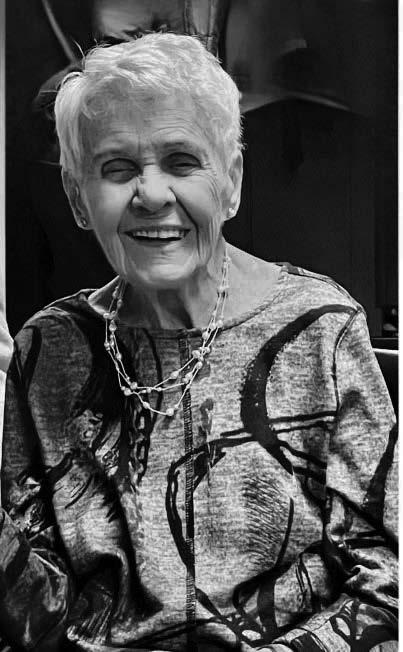
Mary Irene (nee Kiley) Bowman, 99, r Forest, died peacefully on June 23, 2024 surrounded her loved ones. Born on Nov. 6, 1924 to Bernard and Irene Kiley in Chicago, she was a lifelong supporter of rinity High School, ich she and her six daughters aduated from Row Dominican University). de gree in sorsity in Chicago, her life, Paul Clarke wman Jr. They married on Oct. 8, 1949. Passionate about her faith, she was a great supporter of the Haymarket House in Chicago founded by Monsignor Ignatius McDermott, a dear friend of hers from Loyola. She and her husband volunteered at the Apostolate for the Handicapped for many years, along with countless other charitable works.
With her contagious smile, great sense of humor, and unconditional acceptance, she cared for all and demonstrated this daily. She may be most remembered for her laugh and many stories.
Mary is survived by her children, Mary Kay (James) Mullen, Nancy (the late Ber-
nard) Babel, Patricia (James) Ruth, Susan (Phillip) Mullane, Ellen (Lawrence) Calkins, Paul (the late Shelly) Bowman, Jerome (Mary) Bowman, and Elizabeth (Curtis) Kracht; her 21 grandchildren and 25 great-grandchildren, her brotherin-law Jim and sister-in-law Winnie Bowman; and many nieces and ne phews. In her final days, Mary and her f amily were blessed by her remarkable care givers, Annie and Aida, and her hospice team, Jill and Ir ma.
She was preceded in death by Paul, her husband of 48 years; her mother, Irene; her father, Bernard; her brothers, Bernard and William; her son-in-law Bernard, and her daughter-in-law Shelly.
Visitation will be held on Wednesday, June 26 from 4 to 8 p.m. at Conboy Westchester Funeral Home. Funeral Mass will be celebrated at 11 a.m. on Thursday, June 27 at St. Edmund Catholic Church in Oak Park (please meet at church).
In lieu of flowers, donations can be made to Haymarket House Chicago (www. hcenter.org/ways-to-give).
In a story that ran in Wednesday Journal on May 8, 2024 about Sr. Teresita Weind’s death, and her time at St. Catherine of Siena-St. Lucy in the Oak Park community, we re ported that a Memorial Mass was being planned for July. The date has changed. The Memorial Mass and rece ption for the St. Catherine of Siena-St. Lucy community, all who knew her, will be at 11 a.m. on Saturday, Aug. 24, 2024 at St. Catherine of Siena-St. Lucy Church, Austin and Washington boulevards, with a reception to follow in Maguire Hall.
By MELVIN TATE Contributing Reporter
The foundations of successful high school athletic programs are often developed at the local community’s elementary and junior high schools that feed into them. The better the feeder program, the more likely the high school program will do well.
As he strives to lead the Oak Park and River Forest High School boys basketball program back to prominence, varsity head coach Phil Gary is hopeful that the creation of a new feeder program will be an asset.
“It’s something we’ve been trying to get since taking over,” said Gary, entering his fifth season. “A lot of other schools have feeder programs that help the high schools win consistently. It’s surprising that, being a big school, we didn’t have one up until
this point, but better late than never.”
Starting this fall, the Junior Huskies program will be the official OPRF feeder partner. It will consist of players from third through eighth grades. All participants need to be residents of either Oak Park or River Forest to be eligible. Tryouts will be held in late October, and the season runs from November through February 2025.

PHIL GARY OPRF boys basketball coach
Practices will take place twice per week at OPRF, local middle schools, local park district, and other community locations. Teams will play 20-25 games, including home and away contests with other suburban feeder programs. Additionally, there will be two feeder tournaments each year.
“I’ve been getting a lot of positive feedback from the community, thanking me for starting this,” Gary said. “They’ve been saying that, whatever we need, to reach out
to them.”
The Junior Huskies will not only be for boys; girls are also invited. Program coordinators will be for mer OPRF players as well as community members who, in Gary’s words, “love teaching the game.”
“I went to OPRF, and I want both the boys and girls to be truly successful,” he said. “We’re pretty much together and support each other; that’s what high school basketball is all about.”
While the official website will be online soon, Gary said people who want more information about the Junior Huskies can email jrhuskiesfeeder@gmail.com or PGary@oprfhs.org.
As he develops the feeder program, Gary is also busy coaching the OPRF boys in summer competitions. He likes what he’s seen so far.
“They’ve been doing a good job, and [ris-
ing seniors] Alex Gossett and Alex Vincent have stepped up as leaders,” Gary said. OPRF went 2-2 at the Romeoville Live Event. On June 21, the Huskies defeated Courtmasters 68-45, but lost to Mount Vernon 67-41.
The following day, Vincent turned in a dominant performance against Grayslake North with 25 points and 10 rebounds in OPRF’s 57-40 victory. Gossett added 17 points
Then in the Huskies’ final game, Vincent poured in 16 points and Gossett 14, but it wasn’t enough in a 61-47 loss to Andrew “I thought Gossett, Vincent, and Jerome [Delaney] were really good this weekend,” Gary said. “Our senior point guard, Andrew Zhou, was also really good, making 11 threes in our four games. And Andre Stanton, our 6-10 kid, is developing well, as is Logan Johnson [rising junior and brother of recently gr aduated Max Johnson] .” OPRF c oncludes the summer at the R idgewood High School S hootout, June 28-30.
By MELVIN TATE
Contributing Reporter
The Fenwick High School boys basketball team entered the 21st annual RiversideBrookfield Summer Shootout, June 21-23, without the services of their five football players.
Despite this, the Friars showed well, finishing with a 3-1 record against some of the Chicago area’s top programs.
“I think we did really good,” said Fenwick rising senior guard Ty Macariola. “We have a good group of guys, and I’m excited for the [upcoming] season.”
Fenwick opened pool play with a pair of victories on June 21. In the first game, Macariola poured in 25 points and rising senior Makai Mandley added 15 as the Friars
rolled past Kenwood 50-35. Later, rising senior Kamron Hogan scored 13 points, with Macariola and Mandley each adding 11 and rising senior Deonte Meeks 10 in Fenwick’s 57-41 win over Maine South.
“Makai’s been huge,” Macariola said. “Last year, he didn’t play as well, but now he’s picking it up. He’s hitting all his threes and going to be huge for us this season.”
Fenwick split its two games on June 22. In the opener, the Friars fell to Warren, which features one of the state’s top Class of 2027 prospects in Jaxson Davis, 56-46. Macariola had 12 points and Hogan 10 points, four rebounds, and four assists in defeat.
But Fenwick bounced back with a 54-46 victory over Neuqua Valley in its tournament finale. Macariola had 17 of his teamhigh 19 points in the second half while
Hogan, Meeks, and rising senior Dominick Ducree added eight apiece.
“We didn’t show what we wanted to show against Warren,” said Fenwick coach David Fergerson. “But we bounced back.”
“Coach Ferg got on us, talking about how we needed to rebound more and come out stronger,” Macariola said. “We’re better than what we showed against Warren.”
Fergerson praised the play of Meeks, who stands just 5-feet-6 but always shows plenty of grit and determination.
“He plays really hard and changes things,” Fergerson said. “Momentum-wise, pressure-wise, when he’s getting downhill driving and kicking, he does a good job.”
He was also thrilled with what the Friars were able to accomplish at RB despite missing rising seniors Frankie Hosty and
Nathaniel Marshall; rising juniors Tommy Thies and Timmy Woods; and rising sophomore Jake Thies, all of whom were attending football camps.
“I would love to be 4-0, but I’m not mad at 3-1,” he said. “We’ve lost just three g ames the whole summer and we might be surprising some people, but I’m not surprised because my guys play hard and play defense. For what we have, we’re doing a great job.”
Macariola added that the team feels more comfortable and knows what’s expected as Fergerson enters his second season as head coach.
“I’m happy,” he said. “We’re all clicking and know our roles now.” Fenwick concludes summer play at the Ridgewood Live Event, June 28-30.



PUBLIC NOTICE
Notice is hereby given, pursuant to “An Act in relation to the use of an Assumed Business Name in the conduct or transaction of Business in the State,” as amended, that a certification was registered by the undersigned with the County Clerk of Cook County. Registration Number: G24000214 on June 11, 2024
Under the Assumed Business Name of KEVIN M SHORT PUBLISHING & CONSULTING with the business located at: 1919 MAIN ST #6, MELROSE PARK, IL 60160. The true and real full name(s) and residence address of the owner(s)/partner(s) is: KEVIN MICHAEL SHORT 1919 MAIN ST #6, MELROSE PARK, IL 60160, USA.
Published in Forest Park Review June 19, 26, July 3, 2024
All real estate advertising in this newspaper is subject to the Fair Housing Act, which makes it illegal to advertise any preference, limitation or discrimination based on age, race, color, religion, sex, handicap, familial status or national origin, or intention to make any such preferences, limitations or discrimination.
The Illinois Human Rights Act prohibits discrimination in the sale, rental or advertising of real estate based on factors in addition to those protected under federal law.
This newspaper will not knowingly accept any advertising for real estate which is in violation of the law. All persons are hereby informed that all dwellings advertised are available on an equal opportunity basis. Restrictions or prohibitions of pets do not apply to service animals.
To complain of discrimination, call HUD toll free at: 1-800-6699777.
NOTICE IS HEREBY GIVEN that on Monday 15 July 2024 at 7:00 on in the Council Chambers of Village Hall, 517 Des Plaines Ave, Forest Park Il. the Planning and Zoning Commission will conduct a public hearing to consider a request for conditional use approval to open an adult cannabis dispensary at the following described property:
CIRCLE PLAZA II LEGAL DESCRIPTION LOTS 1,2,3,4 AND 5 IN BLOCK 1 IN RAILROD ADDITION TO HARLEM IN THE SOUTHEST QUARTER OF SECTION 12, TOWNSHIP 39 NORTH RANGE 12, EAST OF THE THIRD PRINCIPAL MERIDIAN, IN COOK COUNTY ILLINOIS Commonly know as 7200-7216 Circle Ave & 25 South Harlem Ave. Forest Park Il. 60305
The applicant is Ed Warpinski of TC Applico LLC dba BLOC DISPENSARY. The property is owned by Bern Real Estate Circle Plaza II LLC. Further information can be obtained by calling the Department of Public Health and Safety at 708-615-6284
Marsha East, Chair
Published in Forest Park Review June 26, 2024
NOTICE TO CONSULTANTS Notice is hereby given by the President and Board of Trustees of the Village of River Forest, Cook County, Illinois, that sealed bids will be accepted for:
2024 Fenwick Priory Watermain Loop Installation Project – Design Engineering Services
This project includes design engineering services of a watermain loop project at Fenwick Priory.
The bidding documents are available for download starting Friday, June 21, 2024 at: www.vrf.us/bids
Bids must be submitted by Wednesday, July 17, 2024 at 10:00 a.m. at:
Village of River Forest 400 Park Avenue River Forest, IL 60305
Proposals will be considered not only on the basis of cost, but also on past performance, experience and ability to perform the work.
No bid shall be withdrawn after the opening of the Proposals without the consent of the President and Board of Trustees of the Village of River Forest for a period of thirty (30) days after the scheduled time of the bid opening.
The Village of River Forest reserves the right in receiving these bids to waive technicalities and reject any or all bids.
Published in Wednesday Journal June 26, 2024


June 26, 2024
THE AUSTIN COMMUNITY PUBLISHED ITS FIRST QUALITY-OF-LIFE PLAN CALLED AUSTIN FORWARD. TOGETHER. (AFT) IN 2018. THIS QUARTERLY PUBLICATION DESCRIBES HOW AUSTIN COMING TOGETHER (ACT) IS SUPPORTING THE COMMUNITY TO IMPLEMENT AFT AND OTHER EFFORTS.




AUSTIN FORWARD. TOGETHER. 2024 QUARTER 2 Special thanks to these Austin Forward. Together. quality-of-life plan legacy investors:
How a closed Austin school will be revitalized into a community asset

RECLAIMING OUR ASSETS PAGE 3 THE DISINVESTMENT AND RESURGENCE OF AUSTIN: A LEGACY OF STRUGGLE AND RESILIENCE PAGE 4
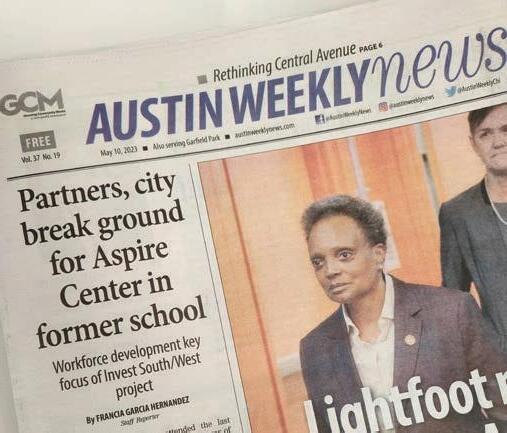
OWNING OUR PATH FORWARD PAGE 7



Since 2010, Austin Coming Together (ACT) has facilitated collaboration to improve education and economic development outcomes in Chicago’s Austin neighborhood.
Today, we serve a network of 50+ organizations committed to improving the quality of life in the Austin community. Our strategic plan is called Thrive 2025 and outlines how we will mobilize our resources to achieve four impact goals by the year 2025: Quality Early Learning, Safe Neighborhoods, Living Wage Careers, and Stable Housing Markets.
Officers
CHAIR
Larry Williams
Broker, State Farm Insurance
VICE CHAIRMAN
Bradly Johnson
Chief Community Officer, BUILD Inc.
SECRETARY
Jerrod Williams
Law Clerk, Illinois Appellate Court
Leadership
Darnell Shields
Executive Director
Andrew Born*
Senior Director of Community Impact
*Also part of the ACT Leadership Team
TREASURER
LaDarius Curtis
Senior Director of Community Engagement & Health, West Side United
EXECUTIVE DIRECTOR
Darnell Shields
Austin Coming Together
Directors
Sharon Morgan Director of Graduate Support & Community Outreach, Catalyst Schools
Reverend Reginald E. Bachus Pastor, Friendship Baptist Church
Deirdre Bates* Director of Operations
Dearra Williams
Executive Operations Lead/ Assistant to the CEO
Londen Mance Office Administrator
Sandra Diaz*
Service Delivery Enhancement Manager, Austin Community Hub
Emone Moore Engagement Coordinator, Austin Community Hub
Dollie Sherman Engagement Specialist, Austin Community Hub
A House in Austin
Academy of Scholastic Achievement
Austin Childcare Providers Network
Austin Community Family Center
Austin Weekly News (Growing Community Media)
Be Strong Families
Beat the Streets Chicago
Bethel New Life Beyond Hunger
BUILD Inc.
By The Hand Club For Kids
Cara Catholic Charities
Chicago Austin Youth Travel Adventures
Chicago Community Loan Fund
City of Refuge
Defy Ventures Illinois
Erikson Institute
Friends of the Children
Friendship Community Development Corp. of Austin
Greater West
Town Community Development Project
Tenisha Jones
Vice President of Community & Government Engagement, Catholic Charities
Reginald Little
Business Development Specialist, Great Lakes Credit Union
Dawn Ferencak
Senior Marketing Strategist, Chicago Parent
Deborah Williams-Thurmond
Community Outreach & Engagement Specialist, Habilitative Systems, Inc.
Clara Bonnlander
Social Services Coordinator, Austin Community Hub
Ethan Ramsay*
Planning and Investment Manager
Grace Cooper Lead Organizer
Mia Almond Project Coordinator
Housing Forward i.c. stars
IFF
Institute for Nonviolence Chicago
Jane Addams Resource Corporation
Kids First Chicago
KRA Westside
American Job Center
Learning Edge Tutoring (fka Cluster Tutoring)
Ruth Kimble
Founder & CEO, Austin Childcare Providers Network
Max Komnenich
Associate Principal, Lamar Johnson Collaborative
BOARD OF DIRECTORS
Jack Macnamara 1937–2020
FOUNDING BOARD CHAIR
Mildred Wiley 1955–2019
Arewa Karen Winters Community Organizer
Natalie Goodin
Special Projects Manager
Nicholas Galassini
Chicago Neighborhood Recovery Program Associate
Legal Aid Chicago (fka LAF)
Manufacturing Renaissance
Mary Shyrese Daycare
Maryville Academy
Mercy Housing Lakefront
New Moms
OAI, Inc.
Oak Park Regional Housing Center
Open Books
PCC Community
Wellness Center
Project Exploration
Renaissance Social Services, Inc.
Sarah’s Inn
South Austin Neighborhood Association
St. Joseph Services
Marketing & Development
Alicia Plomin* Director of Marketing and Development
Jon Widell Marketing and Development Specialist
Sydni Hatley Marketing and Development Coordinator
The Journey Forward
The North Avenue District, Inc.
Towers of Excellence
UIC Jane Addams
College of Social Work
VOCEL
Westside Health Authority
St. Leonard’s Ministries
Stone Community
Development Corporation
The Catalyst Schools
West Side Forward
Worldvision
Youth Guidance
By Darnell Shields Executive Director, Austin Coming Together
From 2010 to 2020, residents of Austin found themselves increasingly moved by a shared sense of purpose: to reclaim power back over their neighborhood, and revitalize the communal spaces that had long been neglected. This surge of community planning and organizing reflected a growing commitment to collective action and initiatives
that boosted social unity, while also addressing the long-standing issue of disinvestment.
The aspirations for change, however, could not move forward without a solid foundation.
In order to be successful, Austin organizers recognized the need for strong partnerships between local organizations and began working together on strategic resource management. These organizations, ranging from grassroots advocacy groups to established nonprofits, played a key role in uplifting the voices of residents.
Conversations began about transforming underutilized spaces, but with most owned by the City, many questioned whether community input would be taken into account.
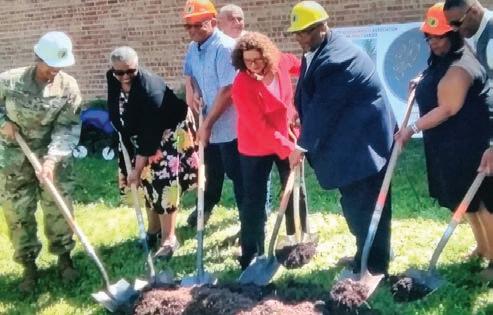

Despite challenges, Austin residents refused to let the community be defined by the neglect and decay that had characterized the area for far too long.
Not only did the project drive positive communitybuilding impact, but it also catalyzed economic growth.
ED SIDERWICZ, CATALYST SCHOOLS CO-FOUNDER, ABOUT THE KEHREIN CENTER FOR THE ARTS.
Through persistence and collective community action, abandoned spaces were revived, such as:
• The Veteran’s Peace Garden
A vacant lot on Madison Avenue was converted into a peaceful oasis by the South Austin Neighborhood Association (SANA), and now serves as an event space to bring together veterans, residents, and stakeholders from diverse backgrounds.
• The Kehrein Center for the Arts
After sitting unfinished inside a school at the corner of Washington and Central, an auditorium built in 1956 was finally renovated to become Austin’s premier performing arts center.
These are just two examples of community-led efforts that prove a combination of grassroots organizing, strategic partnerships, and a steadfast commitment to reclaiming community assets can help lead to a more vibrant Austin.
The community renaissance continued in 2018 with Austin’s first-ever qualityof-life plan and the initiatives that grew from it, including the Aspire Center for Workforce Innovation, a project to repurpose the former Emmet Elementary School into a central hub for on-site job training and complimentary services. n

The history of Austin is evidence of the complex interplay of social and economic forces combined with the enduring spirit of its residents. From its humble beginnings in the late 19th century to its struggles with disinvestment and urban decay in more recent decades, the story of Austin is one marked by both resilience and adversity.
In 1893, the seeds of Austin’s development were sown. This pivotal year saw the construction of one of the community’s first schools, laying the foundation for future growth and prosperity. With Austin becoming part of the City of Chicago in 1899, the Robert Emmet School emerged as a cornerstone of the neighborhood.

During the early 20th century, Austin witnessed a period of rapid expansion fueled in part by the development of street railways and the allure of its infrastructure to a wave of European immigrants. The community’s population increased greatly, and by 1913, the Robert Emmet School expanded to accommodate the boom. The area was estimated to have over 140,000 residents by the 1920s.

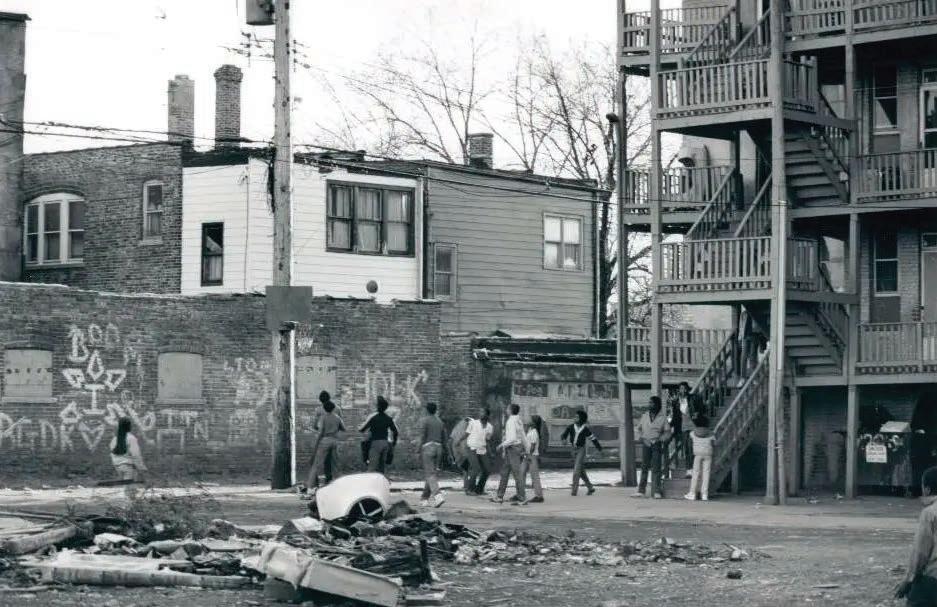
A large wave of African Americans moved to Austin toward the end of the Great Migration. The trajectory of the neighborhood took a tumultuous turn. The arrival of African Americans seeking refuge from the Jim Crow South led to a wave of white flight, driven by prejudices and racially motivated practices. This exodus resulted in a dramatic decrease in white residents, businesses, and access to city services, setting the stage for decades of disinvestment and neglect to follow.
The 1960s brought a glimmer of hope to Austin with the extension of the CTA Green and Blue Lines, fostering renewed growth and economic activity in the community. Yet, this progress was overshadowed by the assassination of Dr. Martin Luther King Jr. in 1968, underscoring the broader context of racial tensions and social upheaval gripping the nation.
The 1970s and 1980s saw a pattern of disinvestment in Austin with shrinking city resources and job opportunities as the community’s large employers left. Grassroots initiatives were established to address these challenges. Westside Health Authority (WHA) started in 1988, plus many faith-based and civic organizations were created.
The political landscape further shaped Austin’s ascent, with the mayoral tenures of Jane Byrne and Harold Washington carrying cultural significance as well. While Byrne’s administration favored interests of the white community, Washington’s historic tenure as Chicago’s first Black mayor offered yet another glimmer of hope for marginalized communities.
The 1990s saw a troubling rise in crime, with the Chicago Police Department recording 48 homicides in 1992 alone. As issues like public safety grew, Austin also faced other setbacks like diminishing employment opportunities. Organizations in the social sector helped, but often worked separately, unaware of one another’s assets or goals. An urgent need arose for comprehensive community revitalization efforts and in response, Austin Coming Together was created in 2010 and has been coordinating collective impact efforts ever since.
This historical context is the backdrop and inspiration for why there is so much dedication to progress today. Despite the troubles of the past, the commitment and resilience of the community run deep. With more development projects underway than ever before, we are seeing intentional reinvestment in the community. Today, Austin is on a clear path to thriving. n
Community Narrative
TASK FORCE CHAIRS
Briana Shields
Briana Janeé Arts
Kenneth Varner
Healthy Schools Campaign
Dearra Williams
Austin Coming Together
STRATEGY LEADS
Lasondra Kern
Community Resident
Suzanne McBride
Austin Talks
Alicia Plomin
Austin Coming Together
Cindy Gray Schneider
Spaces-n-Places
Jai Jones
PSPC, The Chicago
Community Trust and Community Resident
TASK FORCE CHAIRS
Jerrod Williams
South Austin Neighborhood Association
Heather Sattler
Community Development Consultant
STRATEGY LEADS
Erica Staley
Manufacturing Renaissance
Emily Peters
Jane Addams Resource Corporation
Tina Augustus
Chicago West Side Chamber of Commerce
Roxanne Charles West Side Forward
Melissa O’Dell Defy Ventures
Fanya Berry
Community Resident
TASK FORCE CHAIRS
Crystal Bell
Ella Flagg Young Elementary School (retired)
Charles Anderson
Michele Clark High School
STRATEGY LEADS
Ruth Kimble
Austin Childcare Providers Network
Madelyn James
Austin Childcare Providers Network
Pam Price
Chicago Public Schools
Cata Truss Community Resident
TASK FORCE CHAIRS
Athena Williams West Cook Homeownership Center
Allison McGowan Community Resident
STRATEGY LEADS
Shirley Fields
Community Resident
Rosie Dawson Westside Health Authority
Athena Williams West Cook Homeownership Center
Baxter Swilley Community Stakeholder
TASK FORCE CHAIRS
Bradly Johnson BUILD Inc.
Marilyn Pitchford Heartland Alliance
STRATEGY LEADS
Adam Alonso BUILD Inc.
Edwina Hamilton BUILD Inc.
Gina Young Catholic Charities
Bertha Purnell
Mothers OnA Mission28
Jose Abonce The Policing Project
Ruby Taylor Taproots, Inc.
TASK FORCE CHAIRS
D’elegance Lane
Community Stakeholder
STRATEGY LEADS
Deonna Hart BUILD Inc.
Gina Young Catholic Charities
Aisha Oliver
Lurie Children’s Hospital of Chicago
Helen Slade
Territory NFP
Dollie Sherman
Austin Coming Together
Chris Thomas YourPassion1st
TASK FORCE CHAIRS
Deborah Williams-Thurmond
Habilitative Systems Inc.
STRATEGY LEADS
Arnold Bearden
Community Resident
Crystal Gardner
Protest to the Polls
Sharif Walker
Bethel New Life INTERESTED IN JOINING AN IMPLEMENTATION TASK FORCE?
Contact ACT’s Lead Organizer Grace Cooper at gcooper@austincomingtogether.org

By Sydni Hatley
Marketing & Development Coordinator, Austin Coming Together
In order for change to truly benefit the community it impacts, the people affected need to be involved. Unfortunately, that isn’t always the case.
2023 marks the ten year anniversary of the closure of 50 Chicago Public Schools by Mayor Rahm Emmanuel due to a “lack of enrollment.” Of those 50 schools, four of them were in Austin, including the Emmet School.
The low-income areas these schools were in were already facing disinvestment, crime, and dwindling opportunities, and the closures made matters worse.
The four schools in Austin were taken hold of by outside forces that wanted to redevelop them for personal gain.
A 2016 Austin Weekly News article said “The proposal to turn currently vacant Robert Emmet Elementary School, 5500 W. Madison St., into a medical facility and a community center was met with apprehension and skepticism by most of the Austin residents who attended an Oct. 11 town hall meeting organized by Ald. Chris Taliaferro (29th). While many said that they liked the proposal in theory, they were worried about how it would affect the neighborhood residents and businesses.”
As a result of negative opinions and pushback from the community on the city’s initial plan, Westside Health Authority acquired ownership of the property in 2018. Around the same time, Austin published its first-ever quality-of-life plan called Austin Forward Together (AFT), a roadmap to achieving the shared vision of a thriving community. The AFT plan’s goals include everything from public safety to improving access to jobs.
Many efforts were birthed from the plan, such as the $121-million-dollar ASPIRE Initiative, a collection of four projects that will create a cradle-to-career pipeline for Austin residents, all strategically clustered around existing assets in an area bound by Madison, Chicago, Central, and Laramie Avenues: the Aspire Center for Workforce Innovation; a new early learning, health and recreation center called The Aspire Education & Wellness Campus; new programs and support to increase enrollment at the Austin College and Career Academy; and Aspire Housing, a multi-tiered approach to provide homeownership assistance, plus new or renovated units for sale.
One particular concern… was that the new facility wouldn’t actually benefit residents, especially when it comes to jobs.
2016 AUSTIN WEEKLY NEWS ARTICLE
The first ASPIRE effort to begin was the transformation of the three-acre Emmet School and site into the Aspire Center for Workforce Innovation. Construction is already underway, and once open, the Center will help progress many AFT goals by increasing access to job training in living-wage careers like manufacturing; attracting major commercial anchors; creating paths for youth
interactions with mentors and role models; and much more.
Now, Emmet is the only one of the four Austin schools closed in 2013 that embodies the community’s desire to responsively have their needs addressed.
By offering economic and career development opportunities, the Aspire Center for Workforce Innovation is adding to the momentum that has been building over the last decade.
The northeast corner of Madison and Central Avenue is no longer a reminder of Austin’s inequitable past, but an engine of new opportunities for generations of Austin families.
The Aspire Center symbolizes a turning point in Austin. It isn’t just about renovating a building, it is about leveraging Austin’s unbeatable spirit and limitless potential. n


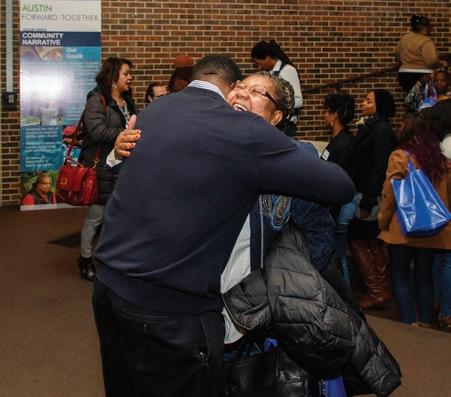

Chicago’s Austin community is full of incredibly passionate individuals and groups who truly care for one another. It has beautiful architecture, a rich history, and an immense potential for growth. Unfortunately, decades of disinvestment have led to a complex array of challenges that have created barriers to food access, quality education, and well-paying jobs.
Austin Coming Together (ACT) has worked alongside our 50+ member network to serve and care for Austin families since 2010. ACT’s Austin Community Hub and its provider network engage Austin residents in order to build trusted relationships and help them get connected to opportunities that improve their lives!
150 INDIVIDUALS ASSISTED in connecting to resources last year
$140K FINANCIAL ASSISTANCE directed to families
Show how much you Join the #AustinCares campaign today!
JOB TRAINING AND HOUSING continue to be the most requested resources